You are here: Home » Blog » Happiness

Why Happiness Is A Journey And Not A Destination
by Christian
Reviewed and fact-checked
We are committed to the highest standards of accuracy and reliability in our content. Every statement made on our website is meticulously fact-checked and supported by authoritative studies.
Read more about our processes here .
Updated on January 29, 2023
“Happiness is a journey.” You’ve definitely heard this before. So what exactly does it mean? If happiness isn’t a destination, then how do we find it? And if happiness is a journey, does that mean we never really get there? Many people swear by this common saying – so are they right, or is it just a cliche?
Your happiness depends on a lot of things, like genetics and life experiences – but as much as 40% is in your control. The way you conceive of happiness can have a big impact on just how happy you are. If you go chasing after it, you may find it slips through your fingers. The expression “Happiness is a journey” is all about thinking about happiness the right way – and finding ways to enjoy all the steps.
There are a couple of different ways to interpret this expression, and each of them will teach you something important about happiness. In this article, we’ll look at all the ways happiness can be thought of as a journey, with examples and actual research to help you apply them to your own life.
I’ll be happy when …..
Affective forecasting in science, a little happiness every day vs a lot of happiness at once, creating your own happiness, active anticipation vs happiness, enjoying the journey and the destination, closing words, happiness as a goal in life.
We often talk about happiness as a goal — something to be attained, like a pot of gold at the end of the rainbow.
The problem with this approach is that we forget to enjoy the present moment. There’s nothing wrong with setting goals for yourself, but if you think achieving a certain goal will finally bring you happiness, you may be in for a disappointment . One reason is that the predictions we make about how we’ll feel in the future aren’t very accurate.
When I was studying psychology at university, one of our professors asked us at the beginning of the course to fill out a survey. Several of the questions had to do with what grade we thought we’d get, and how we’d feel if we got a better or worse grade. At the end of the year, after we received back our grades, we were asked to note our emotional response.
It turns out that almost all our predictions were incorrect. Those of us who got a better grade than we’d predicted at the beginning of the year didn’t feel as happy as we thought we would – and those of us who got a worse grade didn’t feel as bad as predicted!
The ability to accurately predict our future emotional states is called affective forecasting and it turns out that humans are pretty bad at it . We make consistently bad predictions about how we’ll feel:
- When a relationship ends
- When we do well in sports
- When we get a good grade
- When we graduate from college
- When we get a promotion
- Just about anything else
There are a couple of different reasons why we’re so bad at this, but two of the main ones are because we usually overestimate how intensely we’ll feel an emotion and for how long .
Another important reason we’re bad at predicting our emotions is that we usually fail to take into account the complexity of future events. You might think you’ll be happy when you get a promotion – but you may find yourself over-worked, with too much responsibility and not enough time.
Finally, this study found that the more people equate goal-achievement with happiness, the more they’re likely to be miserable when they fail to achieve that goal. If there’s a lesson to be learned from poor affective forecasting, it’s that you shouldn’t count on specific events to make you happy.
Another reason why it’s not great to put all your happiness eggs in one basket is that your happiness depends more on the frequency of happy events , and not the intensity.
In other words, it’s better to have lots of little happy moments than one or two bigs ones. Not only this, but research has shown that happiness from individual events doesn’t actually last that long . And it turns out that one of the best ways to prolong feelings of happiness following an event is to relive what it is that made you happy .
These three studies together tell us something very important about happiness: you should try to maximize the number of small, happy events in your life as much as you can.
Why is happiness a journey and not a destination? Because whatever you think is the destination, it probably won’t make you as happy as you’d like, and you may end up miserable if you don’t get there. It’s better to enjoy little events along the way.
I came across this cute and clever meme today in the gym. Maybe you’ve seen it.
It got me to thinking that one of the reasons why lots of people are unhappy is because they go out looking for happiness, rather than cultivating it in their lives. In a previous article, we explained how happiness is an inside job – it’s something that you can build up from the inside, without having to resort to external sources.
One overview of the paradoxes inherent in seeking happiness came to this conclusion:
Happiness is pursued indirectly as the by-product of meaningful activities and relationships.
While the reasons are manifold (and a bit complex), it looks like “searching for it everywhere” is just about the worst way to go about it. Maddeningly, this study found that valuing happiness as an end goal or destination may “lead people to be less happy just when happiness is within reach.” Finally, when we’re focused on happiness as a destination, we end up feeling like we have less time to enjoy it . So if happiness isn’t a destination we can find and get to, how do we create it?
Well, I already mentioned one article, but the Learn To Be Happy Blog is full of advice based on real-world examples and research on how to cultivate happiness in your day to day life. Some examples include journaling for self-improvement , spreading happiness to others , and (of course!) being physically active . There are lots of ways to create happiness in your life, and studies have shown it’s a lot more effective than looking for it.
Why is happiness a journey and not a destination? Because you may never find the destination, in which case you’ve got a long, long journey ahead of you. So enjoy it! When you get happiness from the journey, you can stop looking for it elsewhere.
Happiness on the horizon
I love facts. Did you know that we share 50% of our DNA with lettuce? Or that a piece of paper folded 42 times would reach the moon? (Turns out you can’t fold a piece of paper more than 8 times. Sorry NASA).
Well, here’s another one of my favorites: people are typically happier planning vacations than after going on them .
In fact, the anticipation of an event is often more enjoyable than the event itself, and we’re happier looking forward to it than we are remembering it. Why is that? Well, it’s due in part to what we talked about in the first part of this article, affective forecasting. We overestimate how much a vacation or some other event will make us happy. But we love imagining it, planning it and getting excited about it!
This is called active anticipation and it’s a fantastic way to enjoy the happiness journey. There are lots of ways to practice active anticipation of an event – you can journal about it, watch movies or read books in a similar vein, or do research on things to do. The important thing is to enjoy the process as much as you can.
This also means you’ll be happier if you always have something good on the horizon, whether it’s a trip, a play, a dinner with friends, or just a nice meal at the end of the week.
If that seems contradictory to the first two interpretations of Happiness as a journey, remember to focus on active anticipation — take as much pleasure as you can in planning the details.
This doesn’t mean you shouldn’t enjoy yourself at the party! But it does mean that you should try to enjoy planning it too. Don’t attach your happiness to the upcoming event. You can look forward to the event without saying to yourself, “I’ll finally be happy when I go on vacation”, or “I’ll finally be happy when I see my friends!”
The point is to enjoy all of it – the journey there and the destination.
Why is happiness a journey and not a destination? Because the journey can be a lot more fun than the destination itself, and if you take the time to really enjoy each step along the way, you’ll spend more time being happy. Having something to look forward to helps you be happier in the present, which means that the journey is never really over. When you reach one destination, just keep on trekking!
💡 By the way : If you want to start feeling better and more productive, I’ve condensed the information of 100’s of our articles into a 10-step mental health cheat sheet here. 👇
This Cheat Sheet Will Help You Be Happier and More Productive
Thrive under stress and crush your goals with these 10 unique tips for your mental health.
We’ve seen a number of different ways that happiness is best thought of as a journey and not a destination. It turns out that people are happiest when they have something to look forward to, when they enjoy the steps that take them there, and when they don’t attach too much importance to individual events.
On the flip side, focusing on happiness as a destination to be found or reached, putting all your hopes on big life events, and aiming for one or two really happy moments rather than a series of little ones, are all things that can make you less happy. It turns out the cliché is true: happiness really is a journey, one to be enjoyed to the fullest.
Now I’m looking forward to hearing from you! Have you experienced things similar to what I discussed in this article? Did I miss something? I’d love to hear about it in the comments below!
Academic researcher and writer with a passion for statistical analysis, neuropsychology and mental health.
2 thoughts on “Why Happiness Is A Journey And Not A Destination”
Great article. I was a very unhappy person when I was younger and it took me a long time to realize that happiness was up to me, not up to the world or people around me. Now, I look for things to be happy about every day. It has changed my life.
Thanks for sharing, Sherri!
Leave a Comment Cancel reply
- Community Forum -
- Members Search -
- Magazine Forum -
Why happiness is a journey, not a destination (and 5 ways to enjoy the ride)
- RELATIONSHIPS
- PERSONAL GROWTH
- SCIENCE & PSYCHOLOGY
- HEALTH & BODY
- ART & CULTURE
- INSPIRATION & SPIRITUALITY
Instead of striving for happiness through end goals or objects, try cultivating day-to-day well-being. Because, as Calvin Holbrook explains, science shows that happiness really is a journey and not a destination.
'Happiness is a journey, not a destination’ is an often-heard saying, and many people would argue that the search for well-being is the greatest motivator of all humankind. But does this motto really hold true? And what does science have to say on the subject?
The expression suggests that humans shouldn’t believe that reaching a certain life goal will award them with happiness. The destination in question could be one of numerous end-points we're often striving for in life: that dream job, buying a first home, meeting the perfect partner, or snagging that huge pay rise you've been working so hard for.
RELATED: Money can't buy happiness (except when you spend it like this!)
Chances are if you do reach one of your destination life goals, you may indeed feel happier – but only temporarily. Why? Because of our happiness set-point .
Happiness journey vs destination: set-point

Our set-point largely determines our overall well-being, and all of us have different levels. Therefore, those with higher set-points will be happier most of the time compared with those that have a less joyful outlook (due to their lower set-point).
Going through our life journey, we oscillate around this set-point. Unhappy life events shift happiness levels below their set-point while positive or exciting events boost your happiness levels above it.
RELATED: Is happiness genetic?
However, sooner or later, when that event becomes normalized or changes, happiness levels return to the original set-point (for example, when we feel the 'holiday blues' after coming back from the high of a recent holiday).
Likewise, once you reach your supposed happiness destination, it may not last, or something may get in the way of the perceived happiness you thought it would bring. For example, after getting what you thought was your dream job, you actually discovered it brought you a lot of negative stress due to the additional workload (and your demanding new boss). That dream new apartment you bought? Well, the noisy neighbours upstairs are doing their best to destroy your peace. Just met your 'perfect' partner? You'll soon discover all the things about them that drive you up the wall! Well, you get the picture.
“Chances are if you do reach one of your destination life goals, you will indeed feel happier – but only temporarily.”
Additionally, at some point these final destinations may dissolve all together. Indeed, as the only consistent thing in life is change, believing that happiness is a destination rather than the journey itself makes little sense. In fact, this pursuit of happiness – the constant desire and drive to achieve things we believe will boost our well-being and joy – often ends in disappointment (the so-called ‘ happiness trap ’. )
Improving your journey to happiness
As discussed, according to Lyubomirsky, our genetic set-point is responsible for around 50 per cent of our happiness. The remainder depends on our circumstances (10 per cent ) and our life activity (40 per cent).
However, some studies suggest that by changing our day-to-day life activity – focusing on our journey and not a final destination – we can boost our internal set-point to a higher level and become happier. Indeed, there are many smaller, everyday activities we can choose to improve our general well-being. So, here are five that you can employ right away.
Studies show we can fix our happiness set point higher by helping others. In fact, according to one — analyzing data from the German Socio-Economic Panel Survey – the trait most strongly linked to long-term happiness increases is a regular commitment to altruism. It showed that the more compassionate we are, the happier our life journey seems to be. RELATED: The benefits of kindness
This was backed up by another study by Sonja Lyubomirsky published in the Review of General Psychology in 2005. When she had students perform five weekly acts of kindness over a period of six weeks, they noticed a significant increase in happiness levels compared to a control group of students.
2. Practise gratitude
Cultivating gratitude is scientifically-proven to increase your happiness journey, and is one of the simplest life changes you can make as it requires little effort.
“As the only consistent thing in life is change, believing that happiness is a destination rather than the journey really makes little sense.”
According to a 2003 report in the journal of Social Behavior and Personality , grateful people tend to appreciate simple pleasures (defined as "those pleasures in life that are available to most people”). Indeed, a study published in The Journal of Happiness Studies showed that writing a daily or weekly gratitude journal can make finding happiness easier.
3. Meditate
Starting your day with just five to 10 minutes of meditation will help you to develop your happiness. Try meditating in the morning shortly after waking: the immediate heightened inner clarity it will give you will set you up for the rest of the day.
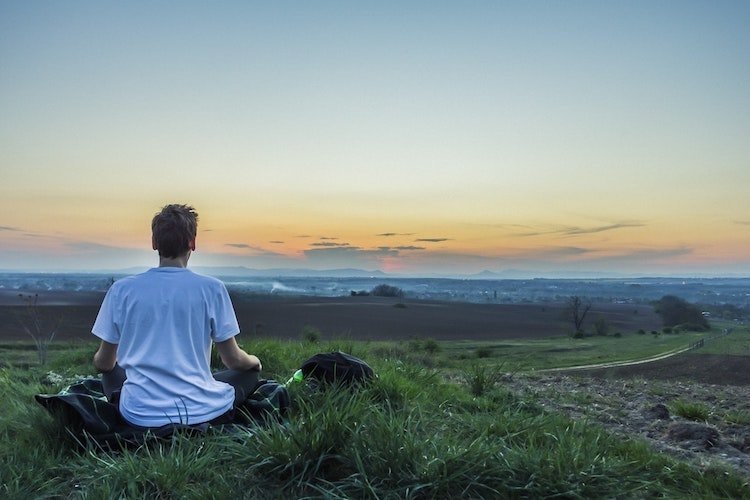
And, according to Psychology Today , meditation is the strongest mental practice that has the power to reset your happiness set point, thus turning you into a more joyful person: regular meditation practice can literally rewire your brain so you can become happier.
4. Build quality relationships
If happiness is a journey and not a destination, then it’s the people that are with you on your journey that can make all the difference. Science is clear on this: you can find and maintain happiness through developing quality relationships.
Humans are a social species and need regular contact. In a 75-year, multigenerational study , Robert Waldinger measured happiness levels in people from Boston’s poorest neighborhoods. He found that the most joyful were those with high-quality social connections.
5. Choose happiness
Bronnie Ware, a palliative care nurse who devoted her career to working with end-of-life patients, found a theme in those coming to the end of their lives: they has a deep regret about not ‘letting’ themselves be happy. Ware, the author of The Top Five Regrets Of The Dying , penned a blog for the Huffington Post , in which she wrote:
“Many did not realize until the end that happiness is a choice . They had stayed stuck in old patterns and habits. The so-called 'comfort' of familiarity overflowed into their emotions, as well as their physical lives.
“Fear of change had them pretending to others, and to their selves, that they were content. When deep within, they longed to laugh properly and have silliness in their life again ... Life is a choice. It is your life. Choose consciously, choose wisely, choose honestly. Choose happiness .”
RELATED: Cherophobia – the fear of happiness explained
Conclusions
All to often we are led to believe that by obtaining goals or possessions we will feel happier. But the reality is – and science agrees – that when we reach those destinations, our happiness levels quickly return to their original set-point. Indeed, happiness often leads to success, but success does not always lead to happiness. Instead, research shows that the best way to maintain consistent well-being is to focus on the everyday changes you can make in your life, with altruism, gratitude and quality relationships being important factors: happiness really is a journey and not a destination.
In fact, research in the field of positive psychology has shown that happiness is a choice that anyone can make. As psychologist William James put it, “The greatest discovery of any generation is that a human can alter his life by altering his attitude.” ●
Main image: shutterstock/Olga Danylenko
happiness.com | The fine art of being: learn, practise, share
Are you a happiness.com member? Sign up for free now to:
■ enjoy our happiness magazine ■ share and support in our happiness forum ■ Develop with free online Academy classes
Friendship | Empathy | Deep listening | Loneliness
Written by Calvin Holbrook

YOU MAY ALSO LIKE
Managing stress and work: tips to help manage business stress .
Stress management is creating a healthy routine and strategies that provide a healthy way to relate and unwind. Business stress is not uncommon to us
Navigating life: 10 tips for overcoming obstacles
Life is seldom smooth-sailing. Sonia Vadlamani shares some helpful, research-backed ways that can make navigating through life obstacles a great deal
Volunteering at Samaritans: “I feel lucky to be there for people when they need someone to talk to.”
Volunteering is a rewarding experience that can unlock a host of benefits. James Frew explains why he started volunteering for the Samaritans
Why is volunteering important? Here are 7 benefits it offers
Are you considering volunteering? It's an important way to help individuals and communities in need. And, as Calvin Holbrook writes, the benefits of
Join the conversation
You are posting as a guest. If you have an account, sign in now to post with your account.
× Pasted as rich text. Paste as plain text instead
Only 75 emoji are allowed.
× Your link has been automatically embedded. Display as a link instead
× Your previous content has been restored. Clear editor
× You cannot paste images directly. Upload or insert images from URL.
- Insert image from URL
- Submit Comment

Posted August 16, 2021
Reminds me of the verse by Alfred D. Souza that goes:
"Happiness is a journey, not a destination.
For a long time it seemed to me that life was about to begin - real life.
But there was always some obstacle in the way, some unfinished business, time still to be served, a debt to be paid.
At last, it dawned on me that these obstacles were my life.
This perspective has helped me to see there is no way to happiness.
HAPPINESS IS THE WAY.
So treasure every moment you have and remember that
time waits for no one."
Share this comment
Link to comment, share on other sites.
Posted June 24, 2021
Happiness is a journey. I am not sure if I agree with the picture. However, I agree with the point made in the article. Happiness is not a destination that you reach, and then it's all sorted. The picture of the journey still implies a destination, and that's what seems wrong to me. I'll keep thinking of an image that resonates better with me.

Posted May 11, 2021
Such an interesting article, and I think it's always important to remind ourselves that happiness is a journey, not a destination. It's so easy to think you'll be happy once you've reached a certain goal, but the most important thing is really to enjoy the journey you are on and look for happiness in the smallest thing along the way. Don't compare yourself to others!
Posted October 5, 2020
The purpose of this letter is to express my appreciation for sharing your valuable insight into personal growth. Its articles like “Why happiness is a journey, not a destination (and 5 key ways to enjoy the ride)” which gives those who are struggling hope for the future, as it pushes them to keep fighting their depression. I admire your view on happiness and your explanation of how it is a journey and not a destination. I also appreciate that you have provided readers with an amazing set of healthy coping strategies such as being kind and practicing gratitude. As when a person is depressed and/or anxious it may become very tempting to turn to unhealthy coping strategies such as drugs or alcohol to provide an ‘easy way out.’ However, these unhealthy coping mechanisms provide temporary happiness and will end up making them feel worse in the end. I thank you for taking the time to provide those who are struggling, with healthy and natural ways to bring themselves some relief.

Posted April 30, 2019
Nice article
Similar articles
How bdsm submission brought me inner happiness.
Finding happiness isn't always as simple as opening a box labeled joy. Some people find it in the most unexpected places, like BDSM submission.
Self-compassion: a visual guide
Having a bad day? Don't beat yourself up: get some self-compassion instead. Thankfully, this infographic from Anna Vital is the perfect
A brief history of the School of Life
Have you heard of The School of Life? It's an organization set up by experts in their field dedicated to improving lives, especially when it comes
Forbidden fruit: the journey to accepting my sexuality
When Princess E started accepting her kinks and desires through exploring her sexual journey, she was well on her way to discovering her inner
Forum discussions
Thank you to happiness to introduce me.
By Ca**** , September 19, 2023 in Introduction Circle - A warm welcome to happiness!

- October 26, 2023
Reaching Out to say Hello! I'm an Inner Peace Coach! Maybe Happiness is a place I can share my voice.
By In**** , August 8, 2023 in Introduction Circle - A warm welcome to happiness!
- September 9, 2023
A warm welcome to happiness, what I want you to know about me...
By Ka**** , August 7, 2023 in Introduction Circle - A warm welcome to happiness!

- August 7, 2023
Share happiness and lifestyle tips with éverobody
By Ch**** , July 14, 2023 in Introduction Circle - A warm welcome to happiness!
- July 14, 2023
HAPPINESS AND ITS BENEFITS
By Kh**** , March 11, 2023 in Happiness & Life Advice Forum
- March 11, 2023
Happiness.com » Magazine » PERSONAL GROWTH » Why happiness is a journey, not a destination (and 5 ways to enjoy the ride)
Journey vs. destination: Motivation experts break down which one to focus on to reach your goals
New studies reveal how to use metaphors to motivate yourself.

Social Sharing
There's nothing more natural than using path- and travel-related metaphors. We've all spoken of "long roads ahead", "heading in the right direction", or "taking a wrong turn." Szu-Chi Huang and Jennifer Aaker , psychologists at the Stanford School of Business, say that path-metaphors aren't just a convenient way to describe our goals. They recently conducted six studies involving over 1,600 people who were pursuing fitness, diet, and educational goals and found that whether people focus on "the journey" or "the destination" makes a big difference to motivation and success. We reached out and asked about the differences between the two kinds of metaphors, and how we can use them to motivate ourselves at each stage on the way to our goals.
Journey versus destination
The destination is "like a dot on the map," says Huang, "It's the desired end-state of all our striving." If you're trying to lose 20 pounds, then 20 pounds lighter is the destination. According to Huang, thinking about the destination highlights the difference between where we are now and where we want to be: "Knowing there is an ideal state and they are not there yet, that gap motivates people," she says. It's not just the beauty of our goal, it's the pain of not yet having achieved it.
Journey metaphors, by contrast, "draw a line from your current state to your future state and illuminate what it looks like." Thinking about the journey calls our attention to all the things we'll need to do, the obstacles and milestones, the highs and lows along the way.
Starting the journey
Big goals can be exciting, but they don't come with directions. It's easy to say "I'm going to get into great shape this year," but that doesn't tell us what to do tomorrow. Therefore, thinking about the journey is especially important right at the beginning.
If you're setting out on a fitness journey, for example, Huang recommends prepping the same way you would for an actual physical trip. "What do we do when we're going on a trip? We buy the equipment we need: the appropriate shoes, the gym membership, whatever tools we need. We prepare by reading books or taking a course." Also, notes Huang, most people don't like to travel alone, so this is the time to find travelling companions with similar goals.
Focusing on the journey also "helps us to map out the milestones and sub-goals that we'll need to reach along the way." At the outset, focusing only on the final destination can be discouraging if we don't have a clear path to get there. Huang says setting out milestones gives us immediate direction, allows us to experience small successes along the way, and builds in opportunities to review whether our companions and equipment are still right for the next stage in the journey.
On the path to victory
According to Huang, whether we should keep our eyes on the prize or focus on putting one foot in front of the other depends on where we are in the journey.
In research for a 2017 article, she found that thinking about the destination can be demotivating in two ways. When our goals seem unattainable, "we tend to disengage because we don't like to commit to things that are impossible." This is especially a problem in the early stages of a journey when the destination is still far-off and we haven't proved to ourselves that we can hack it.
Yet we also disengage when goals are too attainable. "It's a tortoise and hare effect," says Huang, "Losing one more pound sounds simple and I won't care about it much, so maybe I'll just go grab a dessert." When a journey is going well and the end is in sight, small sub-goals seem less relevant and we start to slow down.
When this happens, "It's time to bring back that big destination." Huang suggests using visualization to help bring your final goal to life. "If I want to lose five pounds, I visualize the dress I want to look good in or imagine myself in a situation where my friends can compliment me on feeling so much fitter in my workout class." When we visualize things, it engages our emotions and makes it personally relevant. For Huang, saying she wants to "lose five pounds" won't do the trick, "A number is just a number. There's no emotion around it, no relevance."
How to keep climbing once you've reached the summit
When we reach our goals, it's normal to relax and forget about the long slog that got us there. This makes sense when our goals are limited in scope. But many goals are really about lasting personal change. As Aaker puts it, "The point of education is not the diploma, it's to keep learning in the future. The point of getting in shape is not to lose the extra five pounds, it's to keep the weight off and maintain your healthy habits into the future.… In this light, success isn't the short-run win; it's the subsequent activity that you adopt after you achieved your goal."
If we're trying to establish long-term changes, focusing on a destination that we've already reached might hurt our chances. We've closed the distance where we are and where we want to be that used to motivate us. This is why people tend to revert to their old behaviours once they've achieved a fitness or weight-loss goal.
The six studies on fitness, dieting, and educational goal that Aaker and Huang recently published revealed that, "Across each of these studies thinking about success as a journey helps people see greater change and personal growth," says Aaker, "which fuels them to continue eating healthily and continue learning after achieving their original goals."
The reason that focusing on the journey helps people keep up their good behaviour is that it reminds us of the distance we have crossed, the gap between who we were when we set out and who we are now. "When we have positive change, we want to hold onto it. We don't want to go back to how we were," says Huang.
It also helps us internalize the behaviours that we used on the way. As Huang puts it, "If I think about the journey, I feel like I've changed. I'm now the person who works out or is mindful about eating." And when the behaviours become part of her identity, Huang says "I'll do it with or without reward. You don't need to incentivize me and give me points for going to the gym anymore, this is part of who I am."
How do we take advantage of this powerful effect? When you've achieved a goal, take some time to reflect on how you got there. Think of the ups and downs on the way and link the behaviours that you used with the positive change that you experienced. To make this reflection more powerful, Huang recommends documenting your progress along the way. "Take photos if it's a physical change. Journal and take notes along the way, the more personal the better." If you haven't recorded your journey, says Huang, it's still worth doing. "Close your eyes and think for a few minutes about what happened last month. What changed in the last month? These are the things we want to make a connection to using this journey mindset." Either way, the key is to find a sense of positive growth and link it to the behaviours that helped you achieve your goals.
Clifton Mark writes about philosophy, psychology, politics, and other life-related topics. Find him @Clifton_Mark on Twitter.
Related Stories
- Experts share mental strategies for achieving your fitness goals
- Video A 20-minute beach HIIT workout to take with you on winter vacation
- 15 helpful reads to help you achieve your goals for 2020
- 7 reasons to feel better about taking your workouts indoors for fall and winter
- How to get into any of these hot fitness routines — even if they seem scary
Why Happiness is a Journey AND a Destination
Roman russo: author of optimal happiness.
- January 26, 2024
- Psychology of Happiness
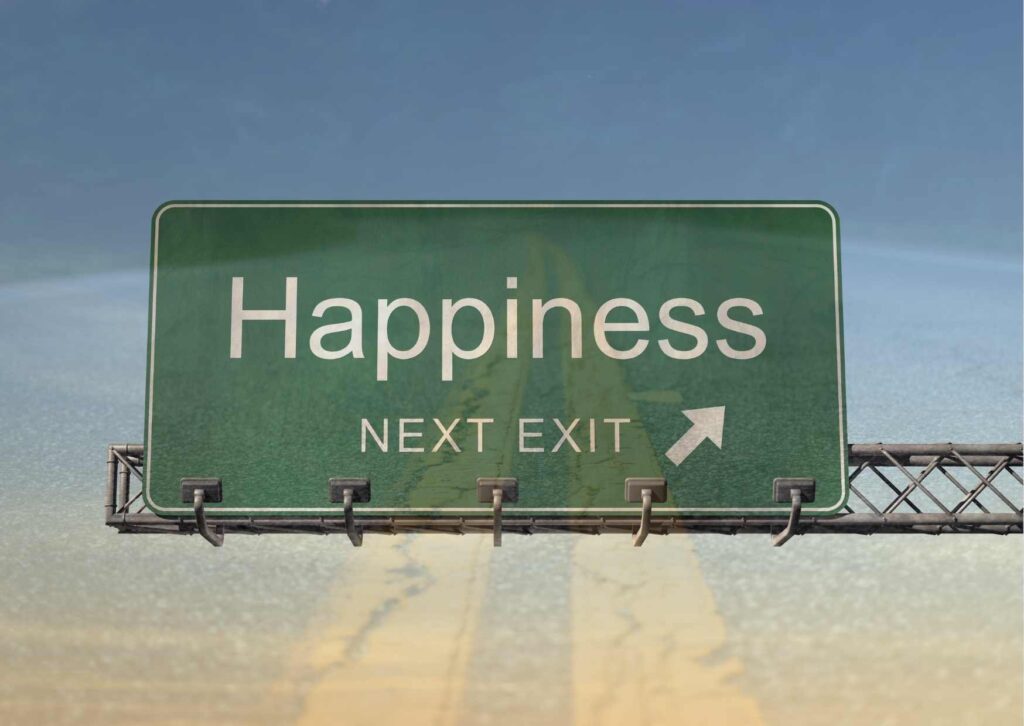
People believe that happiness is a destination because they are looking for something finite and concrete in their lives, such as money , cars , power, success, education , career , and family . They believe that once they achieve these things, all the pieces of the happiness puzzle will just fall into place and they will automatically become happy.
However, most people discover that once they achieve a goal, they are still not as happy as they originally expected to be, and they start chasing the next goal in an infinite loop, never really able to achieve and maintain the true and unconditional happiness they want. And this is why perhaps why Buddha said that:
Happiness is a journey not a destination . Buddha
After all, achieving and holding onto happiness isn’t really possible since happiness is a rather fleeting, evasive, and ever-changing emotion , meaning that even if we can experience happiness at one point, we may later become unhappy again because:
- We may get used to what we have, known as hedonic adaptation ,
- The things that make us happy may change, or
- We may want something else to be happy.
In this way, Buddha said that happiness is a journey because reaching one goal and moving on to the next can take time, life never stops, and we have lists of things that we want to achieve, so we might as well learn to enjoy the ride, which is life.
At the same time, happiness is both a journey and a destination , because our life changes, often for the better, once we achieve certain goals, meaning that our efforts can actually add up to something tangible and significant, which affects our well-being. Sure, we still need to enjoy the journey, and after we reach one destination, we need to start working on reaching the next destinations, which is why we also need to learn to enjoy the journey. Our journey matters, our goals matter, and we can improve our lives by taking the “right” actions.
Happiness is Not a Destination
There is no “and they live happily ever after” or “happy endings” according to happiness literature. Life is a continuous, ever-changing, living, breathing entity that cannot be achieved and maintained indefinitely. We constantly need to work on our well-being and maintain a this positive state through a continuous positive stream of action .
Therefore, happiness is not a destination, but rather a series of movements designed to improve our well-being. Hopefully, these movements will add up to something significant that we can call happiness, but even if they don’t, we should still be able to enjoy our life, every moment of it.
We cannot simply press a “skip” button to take us from one destination to the next, as was done in the movie Click (2006) , where the protagonist essentially skipped the entire journey and went straight to the destination, but in doing so, he skipped his whole life, ending up with a pile of deathbed regrets :
Instead, the protagonist was able to find his happy ending by being allowed to go back in time and learning to enjoy the ups and downs of life as they happened to him. He savored every moment, even the bad ones, realizing that this is all we have – one life, and one continuous “happy ending” – a continuous journey we embark on.
Happiness is a Journey
Additionally, a life without problems is unrealistic, as we will always have problems, no matter who we are and what we do, and it is delusional to think otherwise. Even super rich people experience unhappiness , despite their vast fortunes and influence. So, in a way, being rich and influential may not be the best goal if what you really want is to be happy, or as the famous comedian Jim Carrey once said:
I hope everybody could get rich and famous, and do everything they ever dreamed of, so they would know that it’s not the answer.
Simply put, good and bad things will happen to everyone, with smaller good or bad things happening more often than major events. In other words, something extremely good or bad will eventually happen to you, me, and everyone else, and it is just a matter of time before it happens to us, so we might as well anticipate and prepare for it rather than blaming or praising the universe when it does happen.
I’m not saying this to scare you or make you unhappy, but rather to set realistic expectations. Happiness is a journey, not something finite and concrete. We will experience ups and downs on a continuous basis, so we should learn to roll with the punches and enjoy every moment of it.
Happiness is Both a Journey AND Destinations
Human beings are not designed to be idle and we always need to be doing something, meaning that anyone who tells you that happiness is found in relaxing, procrastinating, and being idle is only telling you half of the story.
Sure, we should continue building ourselves up by setting goals and aiming to continuously improve our situation. Still, happiness is not a destination, but a way of life that we address on a day-by-day, moment-by-moment, and goal-by-goal basis. We make the most of what we can and hopefully learn that we can be happy regardless of who we are, where we are from, and what our life circumstances are.
However, what we do matters—the destination of our goals matters. We can’t just throw up our hands and say that it doesn’t matter what we do, as our actions can lead to positive outcomes, while negative actions or inaction can lead to unhappiness.
In this way, when Buddha said that “happiness is a journey, not a destination,” he meant to say that we shouldn’t obsess about the destination and forget to live our lives in between achieving these goals. However, he didn’t say that we should forget about trying to improve our lives, fix our problems, or try to build something tangible that will positively affect our well-being, as this is exactly how we become and maintain our happiness.
So even if things get bumpy, remember that this is also part of the process. We need to learn to enjoy every moment of it never stopping to try to build something new and bigger.
This is essentially what we teach here at Optimal Happiness: helping people navigate through the rough patches and teaching them them the fastest and surest way to become happy today and forever. So, if you’ve read this far, know that you can book a free 30-minute call with one of our experts who can assist you in becoming the best and happiest version of yourself, helping you shape your “happily ever after” journey and destination.
29 thoughts on “Why Happiness is a Journey AND a Destination”
“However, he didn’t say that we should forget about trying to improve our lives, fix our problems, or try to build something tangible that will positively affect our well-being…” So gratifying to read that line! This gets lost when people teach/talk about the Buddha. He would not have achieved enlightenment had he not SET OUT to find the way to end suffering. According to Buddhist canon it was a seven year journey…with a destination…that led to the next journey!
I agree, Buddha himself tried different things, such as leaving the palace and royal life, practicing asceticism, and seeking guidance from various gurus as he journeyed towards enlightenment. He progressed from one stepping stone to the next, from one goal to the next, while still finding joy in life. However, even for Buddha, it took time to attain enlightenment. This means that he too had to face the struggles of life and view it all as a continuous journey with multiple intermediary destinations.
Great reflection and important truth. Searching for our “happy ending” and stressing about busy extras explains so much of our suffering, and our inability to see the beauty all around us. We are distracted, lonely and blinded, but I struggle with mindfulness big time.
Thank you for your kind words, Becca. Yes, the concept of a “happy ending” and “living happily ever after” also fascinates me. It is introduced to us from a young age, subconsciously influencing the lives of so many people, but I question whether it is correct. I enjoy being mindful, too, and I also struggle with it at times (I guess just like everyone else), always pledging to do better. I wish you the best on this journey called life. I am happy that our lives have interconnected, even in this small gesture of your reply to my blog post, and I wish you all the best moving forward!
Great post!
Thank you for your support Lisa <3
Love how this post made me think of a podcast I’ve listened to now a few times. In it the therapist (author and life/performance coach: Steve Peters “The Chimp Paradox”) is talking about the theory of default settings in our brains. How dissatisfaction and gauging fairness are our “chimp brain” defaults, like an infant knowing heights are scary. How the “computer brain” is our training kicking in from practice. Been more goal oriented these days than ever before, and one of my favorite things I’ve learned through studying dream manifestation and satisfaction, is the idea that intrinsic goals that can never be truly fulfilled; are some of the most rewarding things we can pursue. Like a friendship, or developing the art of writing, the end will never be attainable. I like to think that happiness is a pursuit, and the hunt for the scraps of joy I can grasp from day to day; are what I live for. This story about a cup of coffee gave me a whole sense of happiness like your post did. Love it too, so thank you: https://youtu.be/qxrNCRhxgho?si=qETw7oaMPc-58pxG
Thank you, Benjamin, for your support, for following my blog, and for sharing your inspirational story. From my perspective, I find inspiration to be incredibly important and I actively seek it out wherever I go. It helps me to stay motivated and push forward each day, even when things get tough. However, beyond just inspiration, I am also searching for a sense of order in the chaos. Happiness is often seen as a messy and complicated topic, so I work to organize and break down the concept in a way that makes sense for myself and my readers. It is definitely a journey, much like life itself, and since happiness is such a crucial driving factor for humanity and so many people struggle with their happiness, I try to assist in any way I can. I truly believe that these efforts will ultimately contribute to something bigger and better. This is my way of making a positive impact in the world, and I am grateful that you have noticed and chosen to be a part of this journey.
Gladly Roman! I love that you can take what I feel and think about some of my purpose and life philosophy, and sum it up into clear concise articulations. Glad you found inspiration in my story too!! From an interview with a scientist studying habit formation and a podcaster (Chris Williamson/Modern Wisdom), where they were discussing their definitions of wisdom, I garnered; “when your intention, action, and results all match”. I struggle to be cohesive with my expressions, my mind dances all over flitting down to alight and jump away each moment, so I find diagrams to be very useful. I embrace the serenity and ambiguity of an oblique chart, like drawing a metaphor; free. These pictures help me weather the storm of ideas and influences that change and shift each moment. My only constructive criticism of the writing in your reply (ironically as I think your writing is more technically correct than mine)is to change, “will ultimately”to “contagiously” or “continuously”!! ❤️
Hehe, I hear you, and I’m not above the law of attraction, so I always act in a way that brings the most attraction into my life (referring to: will ultimately”to “contagiously” or “continuously”!! ❤️). From what you wrote, I gather that being present in the moment may be proving difficult because you “struggle to be cohesive with my expressions, my mind dances all over flitting down to alight and jump away each moment.” In this case, I recommend an easy exercise that may make everything clearer, which is to think 100% about what you are doing. So, if you are at work, think about work. At the grocery store, think about your groceries. And when talking to a friend, think just about your friend. However, when you are at work and thinking about your friend or any other permutation, this is when you get into trouble.
Thanks for inspiring me to add the words “happiness”, “joys”, and “immaterial” to my latest drawing of the mountains and pits of life! We travel level, climbing and falling, the clouds dump on us with frozen rain, but then the sun shines through; and those same gray shards of icy flying meanness, can cast rainbows into our eyes: forcing long held back salty tears of overwhelmingly stacked up joy out. The satisfying sensation of feeling good all over, and showing it by sobbing fiercely….This organization is not to be underestimated in its importance towards the path of spreading hope for a better humanity. Playing for change is rad!! https://youtu.be/3hGSqqhhokE?si=o8nhew3ENv44QgTL
Of course, as I always say, happiness is the #1 goal of life, the main reason behind everything that we do. So yes, sometimes there are ups and downs in life, but ultimately, happiness is possible regardless of who we are, what we do, and where we are from. Thank you for sharing this song and keep on dancing!
Excellent advice!! It fits nicely into my new phone habit…of having a separate business phone to physically represent my work day/personal life delineations of time and mental space. Helpful clarity again, thank you! I know what I have to contribute as my latest progress in practices towards personal growth in my group life coach session next week!! Your latest reply will be fun to read to the group. Additionally, for the second time in my life, I’m going to set an alarm to go off; to remind me of my appointment to worry too…although like last time; I’ll cancel it at the last minute. One task at a time. ❤️
I haven’t written much about happiness at work and more about personal happiness because I think we should address these topics separately. I will get there I promise, but for now it is true that we should think of these parts of life separately, even thought they are connected. What’s your group life coaching call next week is about? You are actually thinking of cancelling it? :)
I’m excited to be further challenged by the premise that addressing the subject of happiness separately at work is the ideal. While I recognize that my work is particularly interwoven with my personal life in ways it isn’t for others, and that skews my perceptions towards them being the same thing; I love to get paid to build boundaries: so looking forward to hearing your insights on the topic. I have found the words “should” and “sorry” to be synonymous with miserable thought. I love to encourage people to give themselves a slice of joy by choosing to use “could” and “thanks” as substitutes as much as possible. Those two concepts are in my Human Resource Department guidelines for operations: “timber pitch yaw and stroke”. As far as the counseling appointment, I am planning on going. The thing I’m cancelling at the last minute will be the “appointment to worry”, as this is a strategy I learned in another counseling appointment years ago, and I love to share it. There are always opportunities to postpone worry, and setting aside time specifically to worry, can be a healthy way to get it done and move on, or cancel it if you’ve worried enough. The group life coaching is guided by the (new to me) theory of “Germanic Healing Knowledge”. It’s less about having an overarching issue that each of us share in common, and more about sharing our struggles and listening to each other’s. The supporting feedback from the counselor, and others in the group relating their experience to ours is cool. Only been once so far. Love it. Looking forward to hearing more of your thoughts about separating work and personal life in the pursuit of happiness….although I feel it would be unethical if I didn’t admit at this point, that I believe happiness is a pursuit, not something possible to maintain perpetually for a healthy individual, and contentment is my goal. I find the highs and lows of happiness and misery to be unsustainable and dangerous, preferring to grasp both fiercely when they occur, but have accepted that neither is safe from my principles, the world, and passing time. One example of this is the new research into accomplishment, that shows how our brain has an area that grows with doing things you find intolerable; like going to the gym when you don’t want to, or asking a girl on a date. Gallows humor would be another example of a way to find joy when happiness is far away. Homicide detectives, Nurses, Doctors, Fire Fighters, and people like me who mitigate mold, rot, rodent infestations, broken foundations etc; utilize it because their life is dedicated to the gnarly aspects of defending survival. I find contentment in dealing with gross, a sense of well being that my life has a worthy purpose, and the small joy of laughing it away helps deal with my perspective; that letting go of happiness for a moment to support the pursuit of it for others: is the sacrifice that decides my value as a worthy citizen. My pursuit of happiness is intrinsically interwoven with the idea, that after 9 days of no running water and electricity, some people will be suffering greatly, some will be taking advantage of them in parasitical ways, and I will be useful. I love how storms and broken things reveal humanity in its myriad of wonderful, but draw the line at being happy at other’s misfortune for giving me an opportunity to shine. Weird how one of the things that is most hilarious, is other peoples misery. How comedians can be some of the most sad people. The bigger the grin, I start wondering what grief is hidden. I hope this gave you a sense of solidarity towards what I see as our shared path. “I would have made this reply shorter, but I didn’t have the time”. I love your work here Roman.
Some times its the journey that makes the destination worth while!
I couldn’t agree more with you, Val Whitewolf Heike!
You bring up a lot of interesting points, Benjamin, and challenge me to unpack them all. I believe happiness is a complex topic and many concepts are intertwined with others, so it is often difficult to address all of them simultaneously. This is why I would need another blog or even an actual sit-down in a cafe for two days just to discuss everything and anything that might come up afterwards, haha. That being said, I believe that people have a choice in what they do, so no one is really forced to become a homicide detective, nurse, doctor, or firefighter. In this way, we choose our fate and our karma. Everything that follows, whether it be happiness or unhappiness, comes directly as a consequence of our actions – or in other words, our actions matter. Then people come to me and say that they are unhappy, when in reality it is their life choices that are making them unhappy. Fair enough, sometimes it is hard to judge whether a certain action will lead to happiness or unhappiness, and we certainly need detectives, nurses, doctors, and firefighters. But does it have to be you doing these jobs? (And by “you,” I mean people in general, not specifically you Benjamin). I mean, theoretically speaking, we can be happy in any job and almost any life circumstances. We can even be happy if we make every possible action that should lead to unhappiness. But my question is, why do this if we have a choice? Why shoot ourselves in the foot? We only live once, and pursuing our own happiness isn’t selfish – there is enough happiness to go around, and our happiness doesn’t have to come at the expense of anyone else’s happiness. So what if someone else feels bad when we are happy because of our happiness? We can’t help these people, at least not in a way that would benefit both parties, because they are just dragging us down and not contributing anything in return.
If you don’t mind, I will leave the topic of work-life balance for now as I don’t have anything specific to say about that, except that it is indeed 1/3 of our life and is connected and intertwined with everything else. This is why what we do at work and our happiness at work also matter.
Also, regarding the statement that “happiness is a pursuit, not something possible to maintain perpetually,” I addressed this topic in a blog post titled “Happiness is NOT Elusive: Here is Why” ( https://optimalhappiness.com/happiness-is-elusive ). In summary, the concept of happiness is complex and often misunderstood. Many individuals, despite their best efforts, unknowingly engage in actions that contribute to their unhappiness. Later, they conclude that happiness is impossible to achieve, as they have tried and failed. However, I argue that happiness is indeed attainable if we make the right choices and avoid the wrong ones. While I cannot outline every step here, based on my personal experience, I have witnessed remarkable transformations and met individuals who were genuinely happy despite their seemingly unfavorable circumstances.
I would love the cafe sit down for sure, and I love that you are so engaging, knowledgeable, and thoughtful in your efforts here on your comment section. I agree that pursuing other people’s interests, at the expense of your own, can be is a way to avoid making better choices and decisions that could lead you towards an improved quality of life….that being said, I find slices of happiness in helping others, and one of the core aspects of the human experience is relationships with other people. The question to me is how to balance my sense of generosity with self respect. Does my pursuit of happiness include healthy loving relationship(balanced reciprocal sacrifice)? If so, where is the line between pursuing my own happiness, and sacrificing mine for the people who matter most to me? I’m wired well for doing dirty tasks that others are repulsed by, and believe it’s one of the best ways a leader can honor their fellow leaders. My takeaway from this thread is, “leading a life guided by your pursuit of personal happiness, can include repulsive duties for others, without it ruining yours; if you’re consciously deciding to do so….carefully.” This has been a huge struggle for me in my life Roman, and I don’t believe we’re in disagreement. The spectrum of choices that can lead to happiness for an individual is unique to their capabilities in my opinion. I like moving pianos for others for instance, as the danger is challenging, I end up sweating, and ultimately more music is brought into the world. There’s always a free piano online when I look, and it’s a satisfying way for me to embrace one of my life’s purposes. Reciprocity is a gauge that helps me to keep from either being taken advantage of by selfish people, or offering too much of myself and falling into codependency. Interdependency is a healthier way, and growing into the practices of maintaining it is difficult for me, but worth it. As far as how others feel, yeah, that’s part of the reciprocal process in a healthy relationship, I’ve found that if I’m not selfish enough, it can lead to their resentment of me. Balancing on the beam of happiness will make some people envious and spiteful as you said, but “the only thing we can control is the view we take from our experiences, not the events themselves”. Shine on!
I loved that article. To me a fundamental aspect of maintaining happiness, is the development of a healthy relationship with grief, rejection, and depression. Learning to embrace the predictable experiences that can lead to perpetual melancholy, so that the process is efficient, instead of brushed under the rug of a happy face; and getting stuck. Tears are healthy and function not just to flush your eyes of dust, but to cleanse your soul of the grime life throws into your sight. You’re a flashlight in the night bro: “genuinely happy despite their seemingly unfavorable circumstances.” https://www.healthline.com/health/benefits-of-crying
Pingback: Difference of Opinion? – TATWIP
I am in pain, but I don’t think a lack of happiness is my problem. I have learned to be happy with little or much. Simple things and experiences are what I value. My problem seems to be past things that haunt me. It’s hard to feel joy when you are in both physical and emotional pain. Thoughts?
@lostandinvisible To answer your question, the first thing I’d like to revisit is the definition of happiness, which consists of all positive emotions (e.g., joy, excitement, and ecstasy), while all negative emotions (e.g., grief, boredom, and pain) are generally referred to as unhappiness. This distinction is important because you mentioned that you don’t want to suffer, so what should you aim for instead? In my opinion, you should aim for happiness which is the opposite side. You can create a little bubble of “enoughness” and try to stay there indefinitely, but in this state, are you truly living your life or just existing? Additionally, you are at risk of anything happening that could break your bubble without any safety margin. Furthermore, your issues with the past, as well as both physical and emotional pain, cannot be addressed in a general manner. We would need to look at these specific situations. However, I want to reassure you that you can work through all the feelings that are making you feel less than perfect, and you can create a life of happiness. I would be honored to accompany you on this journey to discover your best self and help it shine through.
In descending order of exponential potential for my pursuit of happiness, from a podcast episode I keep listening to: “moral deeds for others, moral thoughts for others, self care”. Roman does a good job here of doing the first two in my opinion. “When you give love you get love”. Skip to 1:12:14 for direct reference to the quotes above….or listen to the whole thing, it’s fantastic: https://youtu.be/qRY-foz-ZAw?si=5SttArRYdGXtfXkQ
He said that in the USA, happiness has been on the decline since the 1990s. This is interesting but still consistent with what we already know about the mental health epidemic that is happening worldwide. Still, the question remains: What can we do about it? We can’t just say that “50% of all happiness is genetic” and leave it at that. However, this isn’t practical happiness advice. One thing is certain, as you correctly pointed out, @Benjamin, morals that prioritize making life better for others as well as oneself are what make people happier. Therefore, we can cultivate more of these.
Precisely yes Roman. Does genetic predisposition wholly determine emotional outcomes? With attitude, perspective, and experience? In a few rare outliers on the genetic spectrum probably yes, but not as a general rule for the vast majority of humans, I don’t believe that. My greatest satisfactions come from overcoming challenges, or if they’re not possible to overcome I can find joy by helping someone who is worse off than me. From the same podcast: “Lonely? Volunteer”.
I do believe that many people overthink questions like genetics and their effects on our overall happiness, as it is something that we can’t really do anything about. I mean, it is still nice to know, but I would rather be practical. So regardless of people’s ethnicities, age, gender, genetic makeup, or anything else for that matter, how can we make people happier? And what is the fastest and best way to achieve this outcome? I mean, there are countless roads to Rome, but certainly some roads will take us there faster than others. Additionally, many people keep doing things in their lives that are metaphorically shooting themselves in the foot. Then they complain that they are unhappy, stating that life is full of problems, challenges, and is just unfair. I mean, sure, most people don’t know what wrong things they are doing, so it’s not fair to judge a blind person for not knowing where to walk. However, this is where education comes in, and certainly hope. After all, in terms of happiness, people often struggle with this topic, but realistically speaking, there is a way, a solution for virtually anyone to become their best selves. And this is personally the message I’m trying to address here. We don’t have to suffer, and suffering is optional because we can do something about it!
Leave a Reply Cancel reply
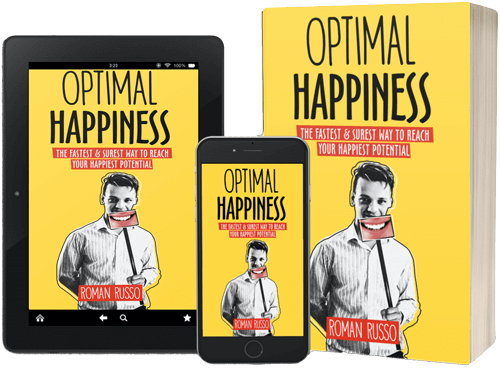
“The problem is that of optimization,” states Roman Russo, author of Optimal Happiness: The Fastest & Surest Way To Reach Your Happiest Potential . There is plenty of advice on how to be happier or less sad, but no one is speaking about how to become the happiest we can be. And this is the difference that makes all the difference. By not looking at our maximum potential for happiness, we fall short of achieving it. After all, we all have hundreds of ideas on how to be happier or less sad, but most people still feel like they are not living their best lives. As such, Optimal Happiness explores the question of how to be the happiest we can be, regardless of who we are, where we are from, and what our life circumstances are. It proposes a complete and unconditional formula for happiness and explains how you too can become happy today and forever, inviting you to join the 1% happiness elite and become one of the happiest people alive.
Recent Posts

The Case Against Mass Unhappiness: The 3 Body Problem

Happiness is an Emotional Rainbow, Not Just a Yellow Color

5 Ways Happy People Become Even Happier

Click Around to Learn More and Become More Productive

Happiness Religion: Positive Intent and Visualization

Being Happy Isn’t Always Rainbows & Butterflies
Follow on facebook, or follow us on, popular categories, happiness newsletter.
Win our exclusive happiness coaching session when subscribing to our transformational Happiness Newsletter.
You May also like

Secret Behind Looking Half Your Age In One Product

Social Equality: No Exclusion, No Borders, & No Social Class

How to be Alone and Happy?

In 2024, If You Want Something, Go Get It
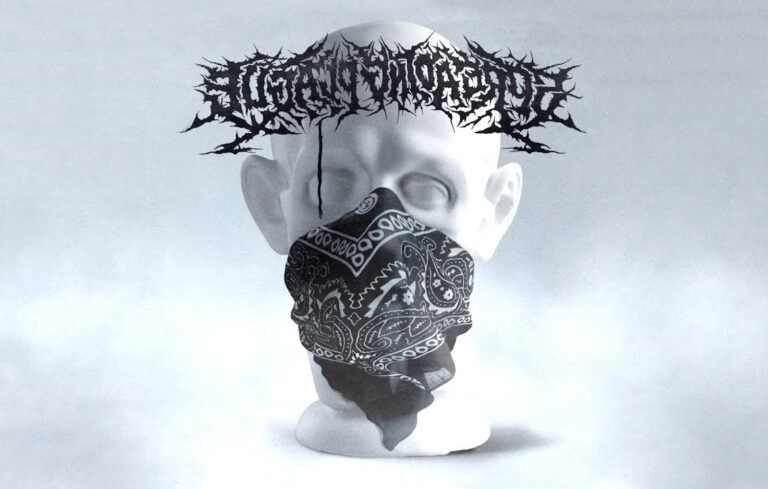
Purposefully Unhappy: Why Negativity Pays Dividends
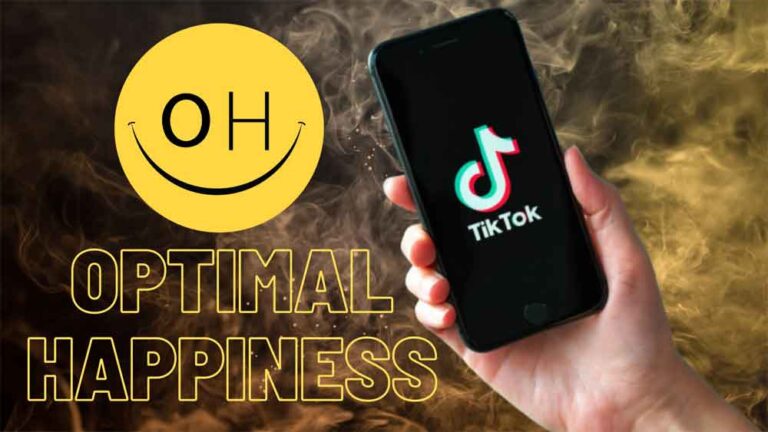
Optimal Happiness is Now on TikTok!

2 + 2 = 3 (or More!) In Relationship Mathematics

What Empathy & Compassion Taught Me About Optimal Happiness
Learn optimal happiness secret formula: become happy today and forever.

We answer the questions “ What is happiness ?” and “ How can I be happier ?” in a lasting way . Reach your happiest potential today , as happiness is your birth right .
Quick Links
Stay happy & in touch.
Join other happiness enthusiasts and receive the latest happiness tips, tricks, and news on your favorite social media channels or via your email. We never send spam!
Copyright © 2024 Optimal Happiness | Disclaimer | Terms and Conditions | Privacy Polic y
How to Find True Happiness (According to Psychology)

There are many philosophical schools of thought regarding the concept of happiness and its cultivation.
For instance, the pursuit of enduring happiness is at the core of many mindfulness practices, which often emphasize gratitude and seeking contentment in the present moment.
Other models of happiness suggest the importance of living in congruence with our values and in ways that satisfy our basic human needs. Some research even shows that whether we are happy or not can, in part, be boiled down to our genetics.
In what follows, we’ll walk you through several conceptualizations of happiness, show you how to measure each, and give you a wide range of strategies for cultivating whichever form of happiness you seek in your own life.
Before you continue, we thought you might like to download our three Happiness & Subjective Wellbeing Exercises for free . These detailed, science-based exercises will help you or your clients identify sources of authentic happiness and strategies to boost wellbeing.
This Article Contains:
What is happiness, how to measure happiness, what is true happiness, the wrong way to search for happiness, 7 ways to find happiness, 3 tips to form habits for happiness, a take-home message.
Defining happiness is no small task, but philosophers and researchers have drilled the notion down to two key conceptualizations.
These conceptualizations are known as hedonia and eudaimonia , and together, they represent two long-running traditions in the study of happiness that stem as far back as the times of ancient philosophers (Ryan & Deci, 2001).
Happiness as hedonia
The hedonic perspective of happiness argues that life’s goal is to experience the maximum amount of pleasure and the minimum amount of pain. According to this tradition, how happy we are can be boiled down to the sum of one’s total hedonic moments (Ryan & Deci, 2001).
When it comes to measuring hedonic happiness, modern psychologists tend to use assessments of Subjective Wellbeing (see How to Measure Happiness below; Diener & Lucas, 1999).
In the past, philosophers of hedonism adopted a fairly narrow view of pleasure and pain related to bodily sensations, appetites, and self-interests. Examples of such forms of hedonia include eating tasty food, enjoying sex, and being free of physical discomfort.
Today, psychologists adopting the hedonic view take an interest in both the pleasures of the body and mind in the broader study of wellbeing (Kahneman, 1999).
This broader, more psychological conceptualization of hedonic pleasure argues that happiness can flow from behaviors that promote mental stimulation, stress relief, feelings of social connectedness, positive mood, and more (Arnold & Reynolds, 2003).
This expanded conceptualization has resulted in the broadening of the study of hedonic pleasure to fields such as economics. For instance, hedonic conceptualizations of happiness are used to understand how shoppers make decisions between purchases, estimating how much pleasure or utility they stand to gain by choosing one product over another (Babin, Darden & Griffin, 1994).
Happiness as eudaimonia
The eudaimonic perspective of happiness presents an alternative to the hedonic view, arguing that true happiness is found when one behaves virtuously. Pursuing eudaimonia, therefore, is about doing what is worth doing .
In line with this, we can think about the eudaimonic perspective as being about reaching one’s true potential and living in congruence with one’s values and true self. It also involves developing one’s talents and strengthening relationships with those for whom we care. By living in this way, one should feel deeply engaged and fully alive (Waterman, 1993).
When it comes to measuring eudaimonic happiness, most researchers tend to use Ryff and Keyes’ (1995) multidimensional scales of psychological wellbeing (see How to Measure Happiness below).
According to the eudaimonic perspective, that which feels pleasurable is not always conducive to wellbeing. Likewise, that which is worth doing does not always feel pleasurable in the present moment.
For instance, volunteering for a cause one feels passionate about may not always feel pleasurable in the hedonic sense. It may involve spending long hours sweating in the sun, getting dirty, or dealing with challenging people or situations. Nonetheless, such pursuits may feed into our eudaimonic happiness as we live in unity with our values.
Interestingly, many traditional philosophers who championed the eudaimonic perspective denounced hedonic views of happiness, declaring them vulgar and overly self-centered. For instance, Aristotle considered hedonic happiness to make humans slavish followers of frivolous desires.
Spiritual conceptualizations of happiness
Today, we can consider a third perspective of happiness which lies in the practice of mindfulness.
Whereas the previous two perspectives consider happiness as something that must be sought, growing schools of thought argue that happiness in the form of contentment or inner peace are primarily available to us at any given moment, regardless of what we are doing.
Consider the following quote from neuroscientist and mindfulness practitioner Sam Harris (2014):
Most of us spend our time seeking happiness and security without acknowledging the underlying purpose of our search. Each of us is looking for a path back to the present: We are trying to find good enough reasons to be satisfied now. Acknowledging that this is the structure of the game we are playing allows us to play it differently. How we pay attention to the present moment largely determines the character of our experience and, therefore, the quality of our lives.
– Sam Harris, Waking Up, p. 3
Mindfulness-based perspectives on happiness and contentment have traditionally been a feature of eastern religions. These traditions hold the view that there exists a source of psychological wellbeing that is not dependent on gratifying one’s desires (hedonia) or pursuing an integrated, self-actualized sense of self (eudaimonia).
Rather, happiness can be achieved by cultivating present-moment awareness and self-transcendence . In other words, these arguments suggest that it is possible to give up the search for happiness and commit oneself to finding contentment in what is happening right now.
A rapidly growing body of psychological and neuroscientific evidence has emerged to support these claims (Hanson, 2009), pointing us toward another avenue for cultivating sustainable happiness.
Overall, happiness is likely to look different for different people. As an individual or practitioner, you may find the most value in considering how all three of these conceptualizations factor into you or your client’s life as a first step toward cultivating enduring happiness.

As noted, hedonic conceptualizations of happiness are often measured using assessments of subjective wellbeing (Diener & Lucas, 1999). Subjective wellbeing regards a person’s cognitive and affective evaluations of his or her life (Diener, 2000).
You can read more about measures of subjective well-being in our other dedicated articles. In these, we explore several commonly accepted measures of hedonic happiness. These include:
- The Positive and Negative Affect Schedule (Watson, Clark & Tellegen, 1988);
- The Satisfaction with Life Scale (Diener, Emmons, Larsen & Griffin, 1985); and
- The Global Happiness Scale (Lyubomirsky & Lepper, 1999)
When it comes to assessing eudaimonic happiness, most scholars apply Ryff and Keyes’ (1995) multidimensional measure of psychological wellbeing (PWB).
The creators’ development of the measure was spurred by their observation that previous studies had treated happiness as synonymous with a balance between positive and negative affect or overall satisfaction with one’s life.
They argued that these approaches were too data-driven and not rooted in theory or lived experience. Therefore, these scholars designed and validated a measure based on responses from a representative sample of telephone interviews (Ryff & Keyes, 1995).
This measure assesses eudaimonic happiness according to six sub-dimensions:
- Autonomy The ability to resist social pressures, regulate behavior from within, and evaluate oneself based on personal standards.
- Environmental mastery Feelings of mastery and competence in a variety of situations, the ability to take advantage of opportunities, and the ability to craft one’s environment to suit one’s needs and values.
- Personal growth Feelings of ongoing development, the realization of one’s potential, and observing oneself changing in ways that signify acquired knowledge and increased effectiveness.
- Positive relations with others Possessing warm, trusting relationships with others characterized by give and take, and the capacity for intimacy and empathy.
- Purpose in life Having goals and a sense of meaning and belief that gives life purpose.
- Self-acceptance Possessing a positive attitude toward oneself, including both one’s good and bad qualities.
Two versions of this scale are available. The first is the original 42-item measure (Ryff, 1989a; 1989b), and there is also a shortened 18-item version (Ryff & Keyes, 1995).
You can find the items for both of these scales, as well as scale anchors and scoring information on Stanford University’s website .
For another useful tool that attempts to reconcile the hedonic and eudaimonic perspectives of happiness, take a look at Hervás and Vázquez’s (2013) Pemberton Happiness Index (PHI).
Upon recognizing that existing assessments of happiness measured either hedonic or eudaimonic conceptualizations of happiness, these scholars sought to design and validate a brief, comprehensive measure that assessed both.
The final 21-item scale also has the advantage of capturing both remembered and experienced wellbeing (Kahneman & Riis, 2005).
The former relies on participants’ memory and judgment about their overall lives, using items like, “I feel able to solve the majority of my daily problems.” In contrast, the latter assesses real-time affective states and feelings about the previous day, using items like, “I learned something interesting.”
As for assessing happiness flowing from conceptualizations in mindfulness, many researchers have administered short scales that capture momentary changes in emotions via diary study.
The purpose of a diary study is to assess fluctuations in states (e.g., moods, thoughts, etc.) throughout a given day. This type of study design, sometimes called a within-person design , runs contrary to many studies in psychology, which typically compare differences between people.
As an example, Diener and colleagues (2010) designed the 12-item Scale of Positive and Negative Experience (SPANE), which was designed to be quickly administered and assess the full range of emotions and feelings a person may experience. The scale, therefore, contains both general and specific emotional terms, such as “pleasant” and “sad.”
Thanks to its brevity, this scale can easily be administered multiple times a day. Therefore, it has been applied in diary studies assessing fluctuations in mindfulness throughout a day. For instance, Ding and colleagues (2019) used the scale in a study examining the link between state mindfulness and present-moment emotions.
The results indicated that state mindfulness was positively related to positive emotions, like happiness and contentment, and negatively related to negative emotions, like depression and boredom.
These authors also found that present-moment rumination, which involves fixation on negative thoughts, partially mediated this effect. In other words, maintaining a mindful state of awareness appears to block ruminative thought partially, helping us to enjoy more positive emotions throughout any given day.
In sum, it’s clear psychologists have done much of the heavy lifting when it comes to developing measures of happiness.
As a practitioner looking to assess your clients’ happiness, you should use the information above as a guide to ensure the content validity of your chosen measure. That is, take care to select a scale that has been shown to effectively assess the conceptualization of happiness (e.g., hedonic, eudaimonic) that you apply in your practice.
Neurological measures of happiness
You may have noticed that the measures of happiness discussed so far have all been self-report in nature. That is, each relies on participants providing information about their own subjective sense of their happiness.
But is there a more objective way to measure happiness?
To answer this question, philosophers and psychologists have been turning to neuroscience to better understand what happiness looks like in the brain.
This research has involved the use of sophisticated technologies, such as PET and fMRI scans, and EEG measures of electrical activity in the brain to identify how happiness manifests physiologically. (Murphy, Nimmo-Smith & Lawrence, 2003; Phan, Wager, Taylor & Liberzon, 2002; Lindquist, Wager, Kober, Bliss-Moreau & Barrett, 2012)
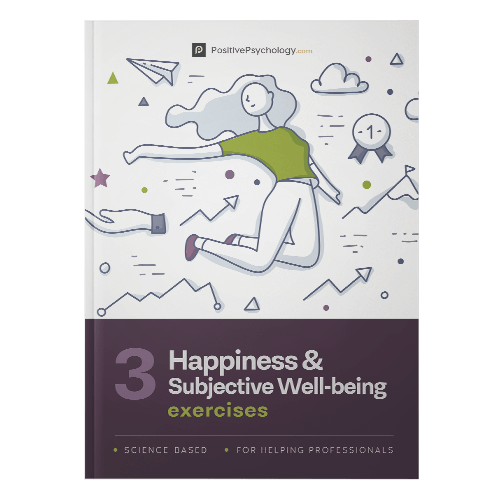
Download 3 Free Happiness Exercises (PDF)
These detailed, science-based exercises will equip you or your clients with tools to discover authentic happiness and cultivate subjective well-being.
Download 3 Free Happiness Tools Pack (PDF)
By filling out your name and email address below.
- Email Address *
- Your Expertise * Your expertise Therapy Coaching Education Counseling Business Healthcare Other
- Phone This field is for validation purposes and should be left unchanged.
To recap, we now have three conceptualizations of happiness: hedonia, eudaimonia, and contentment rooted in mindfulness.
We also have two ways to measure each form of happiness: self-reports and various physiological indicators in the brain.
But the question remains: Is there a secret to finding true happiness?
What has hopefully become apparent is that this question is somewhat of a trick question because there is no agreed-upon understanding of what constitutes ‘true’ happiness.
Think about it.
Imagine racing to your favorite Mexican restaurant and arriving at the ordering counter moments before the restaurant is about to close. The server takes your order, and a few minutes later, you’re handed your favorite taco.
What action would a scholar of each ‘happiness philosophy’ recommend at this moment when you receive your meal?
To a believer of hedonism, happiness would likely represent the moment you bite into the taco and delight in its flavors on your tongue.
To philosophers of the eudaimonic perspective, happiness would more likely involve the ritual of eating with someone you care about, thereby strengthening your connection with that person. It could also mean reaching your potential as a budding cook by learning to create a similarly tasty dish or giving the taco to someone hungry and in need.
Finally, followers of the mindfulness-based perspective would argue that contentment can be found in any or all of the above actions but that it is the quality of your attention, paid to your intentions, sensations, emotions, and interactions with others, that would dictate the happiness you derived from whatever you chose to do with the taco.
In sum, these examples indicate that searching for one ‘true’ source of happiness may be feeding into a fallacy. Rather, there appear to be several pathways to pursuing different sources of happiness.
The remainder of this article will outline scientifically evidenced pathways to cultivating each of these three forms of happiness.
But before setting off on your search, heed one warning…

There are at least three critical bodies of theory, thinking, and research that point to why sacrificing life’s present joy’s chasing happiness is likely to make us paradoxically more miserable.
We have already touched on the first perspective, which is based on the philosophy of mindfulness.
This perspective encourages us to give up the search for happiness entirely, harness our attention, and discover that contentment that can exist in stillness, no matter what we yearn for or have yet to achieve (Harris, 2014).
According to this perspective, by failing to acknowledge that contentment is available to us at any given moment, we will remain dissatisfied. This is because even if we achieve all our goals and get everything we want, some newer, shinier source of happiness will always arise for us to chase.
In other words, the grass will always appear greener somewhere else, meaning it is important to look for happiness wherever we are presently standing.
The second body of thinking lies in empirical findings from the psychology of expectancies and goal-pursuit.
One study in the journal, Emotion (Mauss, Tamir, Anderson & Savino, 2011), found that those who reported valuing happiness highly experienced greater disappointment and ultimately less happiness when circumstances that should have made them happy failed to meet their expectations. In other words, the findings paradoxically suggest that the more we desire happiness, the less likely we are to experience it.
Likewise, there is evidence that placing too much importance on achieving challenging goals in the distant future may also be a recipe for misery.
One study found that students who perceived they made poor progress toward their ambitious life goals tended to exhibit significant depressive symptoms two years later (Salmela-Aro & Nurmi, 1996). Moreover, the study evidenced a downward spiral of depressive symptoms; disappointed students proceeded to derive less enjoyment from their goal pursuits, thereby worsening their symptoms.
Together, these findings highlight the danger of hanging all our hopes for being happy on the realization of future events .
A third reason why chasing happiness may be a mistake relates to a process known as hedonic adaptation (or the hedonic treadmill ). Hedonic adaptation is the observed tendency of humans to quickly adapt to a baseline level of happiness, regardless of significant life events (Brickman & Campbell, 1971).
Indeed, it has been shown that even if one wins a major lottery, the happiness that person derives from day-to-day activities in life will eventually return to baseline (Brickman, Coates & Janoff-Bulman, 1978).
This finding highlights that we should not overestimate the effect that significant life events will have on our long-term happiness, serving as yet another reason to call off the search for happiness (Grant, 2013).
In sum, it is important to recognize that happiness is not somewhere off in the distance. There is always something to be gained by pausing to reflect on our reasons to be happy right now, such as by practicing gratitude.
We will explore this and several other strategies to find hedonic, eudaimonic, and present-moment happiness in the remaining sections.
You don’t find happiness, you create it – Katarina Blom
You now understand a key pitfall to avoid in your search for happiness. Next, let’s consider eight different sources of happiness you can leverage today to find joy in your own life.
Finding happiness through neurotransmitters
The first effective way to boost hedonic happiness is to engage in healthy behaviors that directly target neurotransmitters associated with pleasure.
While there are many neurotransmitters that affect our happiness, there are a few key ones worth focusing on: dopamine, serotonin, oxytocin, and endorphins.
Dopamine, otherwise known as the “feel-good” hormone, is a key feature of the brain’s reward system and associated with pleasure. Dopamine can be triggered in many ways, including through exercise , a healthy diet, sufficient sleep, listening to music, meditating, and ensuring you get a little sunlight each day (Breuning, 2015; Hansen, Stevens & Coast, 2001).
Next is serotonin. This hormone plays an essential role in stabilizing our mood and can be triggered in many of the same ways as dopamine, such as by getting consistent sleep, exercise, and ensuring you maintain a balanced diet (Breuning, 2015; Roman, Walstra, Luiten & Meerlo, 2005).
Third is oxytocin, which is the hormone associated with love, bonding, and close connection. This hormone is boosted primarily through physical touch and closeness with others, meaning that hugs, cuddling, and even simply spending time with others can significantly increase our happiness (Breuning, 2015; Uvnäs-Moberg, Handlin & Petersson, 2015).
The final neurotransmitters to consider are endorphins, which reduce physical pain and act as your body’s natural reward system. To increase this hormone, try engaging in behaviors that are ‘good’ for you, such as exercising or demonstrating sincere acts of kindness (Breuning, 2015). Studies have also shown that consuming cocoa, such as that in dark chocolate, can trigger endorphins in the brain (Ottley, 2000).
This was just a brief snapshot into the neurochemical bases of happiness.
To learn more and gain a range of practical tips to naturally boost your neurochemical happiness, take a look at Dr. Loretta Breuning’s book, Habits of a Happy Brain .
Finding happiness through real goods
A next important step in the search for happiness is to work toward securing the basic necessities for wellbeing and development, or what Aristotle called real goods .
Real goods satisfy the natural needs of our bodies, such as our needs for warmth and sustenance. Examples of such real goods include food, clothing, health, shelter, and safety (Moss, 2012).
We might liken this conceptualization to that of the lower levels of Maslow’s hierarchy , which argues that humans must satisfy basic physiological and safety-related needs before pursuing higher-order needs like esteem and self-actualization.
However, real goods also include “goods of the soul,” such as love, arts, music, and literature (Joseph, 2019). These goods clearly tap into the higher levels of Maslow’s hierarchy, and without them, it may be challenging to achieve eudaimonic happiness.
For instance, without a secure shelter in which to gain adequate rest, we would likely lack the energy to develop a new talent, such as painting. Nor would we gain this talent without exposure to sources of inspiration, such as other artists’ work or cultural influences.
In sum, Aristotle’s principles regarding real goods highlight two courses of action for improving happiness.
First, take steps toward securing the basics for your health and wellbeing. This means eating well, engaging in regular exercise, securing a stable income, and getting plenty of sleep.
Secondly, immerse yourself in environments that will bring out your best. For example, surround yourself with good company, knowledge, and cultures. In practice, this may mean stepping outside your comfort zone by meeting new people, learning new skills, or visiting new places.
Finding happiness through gratitude
Many studies stemming from the eudaimonic and mindfulness-based perspectives point to the practice of gratitude as a key source of happiness.
Gratitude can be defined as “the appreciation of what is valuable and meaningful to oneself… [representing] a general state of thankfulness and/or appreciation” (Sansone & Sansone, 2010, p. 18).
Two simple ways to practice gratitude include taking a moment at the end of the day to reflect on an occurrence for which you were grateful and sending a thoughtful message of appreciation to someone you care about.
For more ideas, take a look at some of our dedicated articles on this topic:
- 13 Most Popular Gratitude Exercises & Activities
- 41+ Gratitude Messages, Letters and Lists
- How To Express Gratitude to Others (19 Ideas + Gifts & Challenges)
- Gratitude Journal: A Collection of 66 Templates, Ideas, and Apps for Your Diary
Finding happiness through flow
Another way to achieve happiness is to take part in activities that bring about the experience of flow, otherwise known as the feeling of “being in the zone.”
In an interview, Mihaly Csikszentmihalyi , the researcher credited with having popularized the concept of flow, explained that those in a state of flow are:
…completely involved in an activity for its own sake. The ego falls away. Time flies. Every action, movement, and thought follows inevitably from the previous one, like playing jazz. Your whole being is involved, and you’re using your skills to the utmost.
(Geirland, 1996)
Examples of just a few activities that can generate flow include games, sports, dancing, cooking, gardening, work, driving, and artistic pursuits (Csikszentmihalyi, 1990).
Most followers of the eudaimonic perspective would view the flow experience as an indicator of eudaimonia. This is because flow experiences entail an optimal level of challenge, enabling us to develop our talents to their fullest (Csikszentmihalyi, 1990).
For more ideas on how to cultivate flow in your life, look at our dedicated articles on the topic:
- The Psychology and Theory Behind Flow
- 11 Activities and Exercises to Induce a Flow State (+ 6 Examples)
- What is Flow in Psychology? Definition and 10+ Activities to Induce Flow
- Flow at Work: The Science of Engagement and Optimal Performance
Finding happiness by living into our values
Several studies have found that making intentional efforts to live in congruence with our values can bolster our happiness or at least buffer against unhappiness (Brown, 2018; Veage et al., 2014).
For clarity, we can define values as “stable, general beliefs about what is desirable” (Feather, 1992, p. 111). Examples of values include fairness, creativity, and freedom.
Understanding our values is critical to achieving eudaimonic happiness because the eudaimonic perspective of happiness encourages us to engage in what is worth doing (Boniwell, 2008). In order to know what is worth doing, we must understand which actions generate valued outcomes, and we can only know this by looking closely at our core values.
Scientists and practitioners have developed a range of useful exercises to help individuals discover their core values. You can learn more about these in several of our other articles:
- 25 Values Worksheets to Enrich Your Clients’ Lives With More Meaning
- The 3 Best Questionnaires for Measuring Values
- Values Clarification: How Reflection On Core Values Is Used In CBT
Once you are clear on your core values, you can take steps to behave in a way that is congruent with these values, helping you live a happier life.
For instance, if you discover that one of your core values is growth, you might then consider the different ways to enact this value in day-to-day life. This could involve registering for a night class or pursuing new intellectual pursuits through reading.
Research also shows that the alignment between our values and professional pursuits plays an important role in determining our overall happiness (Chatman, 1989; Kristof-Brown, Zimmerman & Johnson, 2005).
Based on this, we see the emergence of research on job crafting , which involves altering one’s work to better align it with our preferences (Zhang & Parker, 2019), and that on hiring practices that facilitate good person-job fit (Sekiguchi, 2004).
Therefore, organizational leaders and HR professionals may wish to dig further into some of these concepts to strengthen the happiness of their staff.
Finding happiness through needs satisfaction
One prominent theory of happiness posits that to be happy, we must engage in behaviors that satisfy our three core human needs (Ryan & Deci, 2008):
- the need for competence (feeling effective);
- the need for autonomy (the feeling of being the origin of one’s behavior); and
- the need for psychological relatedness (feeling cared for and understood by other people).
Overall, the satisfaction of these needs represents an avenue for achieving happiness that falls under the eudaimonic conceptualization. This is because need satisfaction promotes long-term wellness rather than just temporary pleasure (Boniwell, 2008).
For a simple assessment to determine your overall satisfaction of core needs within your life, consider completing the 21-item Basic Needs Satisfaction in General Scale (BNSG-S; Gagné, 2003).
Upon completing the assessment, one can calculate their total score for each core need and identify an area for growth as a first step toward fostering greater eudaimonic happiness.
For instance, if you discover that your lowest-scoring need is competence, you might consider whether you can engage in work or hobbies that better utilize your skills, enabling you to derive a greater sense of competence from daily activities.
Again, this was just a brief snapshot into the science of needs satisfaction as a mechanism for achieving happiness. To learn more, look at our dedicated article on self-determination .
Finding happiness through mindfulness
Finally, and at the core of the mindfulness-based approach to finding happiness is the practice of mindfulness itself.
Mindfulness is typically defined as the practice of bringing one’s attention to the internal and external experiences occurring in the present moment, such as sensations, sights, thoughts, and emotions (Baer, 2003; Kabat-Zinn, 1994).
Mindfulness has existed for centuries and was first popularized among eastern traditions. The practice functions to better understand feelings and motivations, train the capacity for attention and relaxation, and free one’s mind from overidentification with negative thoughts and emotions (Fronsdal, 2004; 2006; Harris, 2014).
Often, regular meditation will lie at the core of mindfulness practice. However, other approaches to developing mindfulness can include journaling and yoga .
No matter how you practice mindfulness, the aim is typically for the practice’s benefits to spill over into your experience of day-to-day consciousness, enabling you to return to states of mindful awareness throughout your day and not be at the whim of negative thoughts and emotions.
If you’re interested in cultivating greater happiness through mindfulness, we have a range of articles throughout our blog to help you learn more:
- Mindfulness Meditation Videos, Exercises, Books and Courses (+PDF)
- How To Practice Mindfulness: 10 Practical Steps and Tips
- Practicing Mindfulness in Groups: 9 Activities and Exercises
- 18 Mindfulness Games, Worksheets and Activities for Kids

As with any behavior change, becoming happier requires that one form new, positive habits. For instance, if you wish to target happiness through neurotransmitters like dopamine and serotonin, a first step may be to develop routines and habits associated with good sleep and regular exercise.
Likewise, if you wish to cultivate happiness through regular gratitude practice, commit to setting aside fifteen minutes each evening to fill in a gratitude journal.
Here are three tips related to the science of habit formation to help you develop your new habits for happiness.
First, set a goal to strengthen your happiness using a goal-setting framework . By using a framework to set a happiness goal, you can avoid accidentally setting a goal that is too vague, easily track your progress, and rest assured knowing your goal is realistic and within your reach.
Second, keep in mind that it takes approximately two months for a new behavior to become an automatic habit (Lally, van Jaarsveld, Potts & Wardle, 2010), so do whatever it takes to commit to your goal for at least this long.
That way, you can see if your new practice has enduring benefits and becomes easier with time. For instance, you may find you need to set daily reminders for yourself (e.g., to journal, settle in for bed) for a couple of months until your new habit becomes automatic.
Finally, consider linking up with a friend or small group and commit to becoming happier together. In the same way that groups like AA and Weight Watchers can help their members develop better habits associated with health, you can work with others to stay accountable and get support if you face any hurdles in your pursuit of greater happiness.
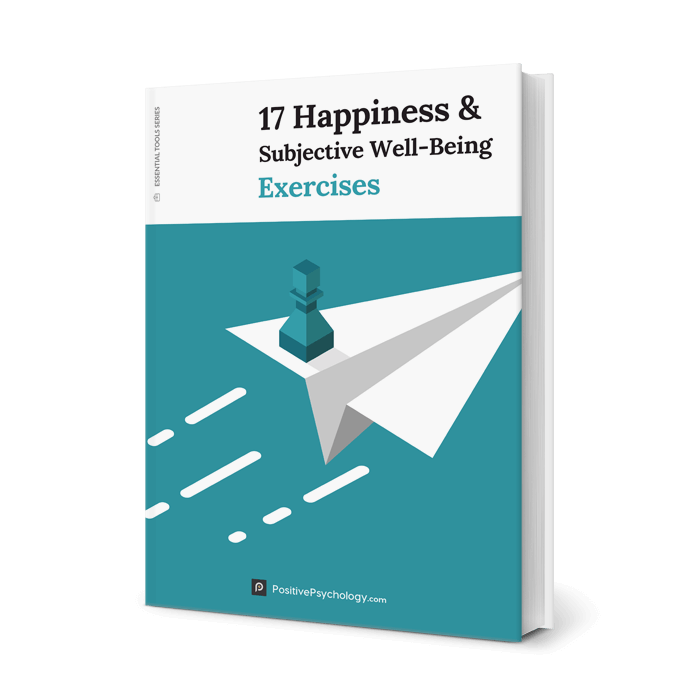
17 Exercises To Increase Happiness and Wellbeing
Add these 17 Happiness & Subjective Well-Being Exercises [PDF] to your toolkit and help others experience greater purpose, meaning, and positive emotions.
Created by Experts. 100% Science-based.
The aim of cultivating human happiness is at the core of positive psychology.
It should, therefore, be no surprise that we have linked to many of our other posts exploring different approaches to fostering happiness throughout our discussion.
Now that you hopefully have a better sense of what you’re searching for when thinking about your own happiness, as well as pitfalls to avoid, we encourage you to select one area for growth. Once you’ve chosen an area, follow the links to read more and commit to developing one new habit for happiness.
By doing this, you’re letting go of the false conception of ‘true’ happiness as something elusive and far off in the future. Instead, you’ll be acknowledging happiness as something that can be achieved little-by-little, right now.
And if you ever find yourself getting lost in your search for happiness, consider reflecting on this famous quote:
Happiness is a journey, not a destination; happiness is to be found along the way not at the end of the road, for then the journey is over and it’s too late. The time for happiness is today not tomorrow.
Paul H. Dunn
We hope you enjoyed reading this article. Don’t forget to download our three Happiness Exercises for free .
- Arnold, M. J., & Reynolds, K. E. (2003). Hedonic shopping motivations. Journal of Retailing , 79(2), 77-95.
- Babin, B. J., Darden, W. R., & Griffin, M. (1994). Work and/or fun: Measuring hedonic and utilitarian shopping value. Journal of Consumer Research , 20(4), 644-656.
- Baer, R. A. (2003). Mindfulness training as a clinical intervention: A conceptual and empirical review. Clinical psychology: Science and Practice , 10(2), 125-143.
- Boniwell, I. (2008). What is eudaimonia? The concept of eudaimonic well-being and happiness . Retrieved from http://positivepsychology.org.uk/the-concept-of-eudaimonic-well-being/
- Breuning, L. G. (2015). Habits of a happy brain: Retrain your brain to boost your serotonin, dopamine, oxytocin, & endorphin levels . Avon, MA: Simon and Schuster.
- Brickman, P., & Campbell, D. T. (1971). Hedonic relativism and planning the good society. In M. H. Appley (Ed.), Adaptation-level theor y (pp. 287–302). New York, NY: Academic Press.
- Brickman, P., Coates, D., & Janoff-Bulman, R. (1978). Lottery winners and accident victims: Is happiness relative? Journal of Personality and Social Psychology , 36(8), 917-927.
- Brown, B. (2018). Dare to lead: Brave work. Tough conversations. Whole hearts . London, UK: Vermilion.
- Chatman J. A. (1989). Improving interactional organizational research: A model of person–organization fit. Academy of Management Review , 14(3), 333-349.
- Csikszentmihalyi, M. (1990). Flow: The psychology of optimal experience . New York, NY: Harper & Row.
- Diener, E. (2000). Subjective well-being: The science of happiness and a proposal for a national index. American Psychologis t, 55(1), 34-43.
- Diener, E. D., Emmons, R. A., Larsen, R. J., & Griffin, S. (1985). The satisfaction with life scale. Journal of Personality Assessment , 49(1), 71-75.
- Diener, E., & Lucas, R. E. (1999). Personality and subjective well-being. In D. Kahneman, E. Diener, & N. Schwarz (Eds.), Well-being: The foundations of hedonic psycholog y (pp. 213–229). New York, NY: Russell Sage Foundation.
- Diener, E., Wirtz, D., Tov, W., Kim-Prieto, C., Choi, D. W., Oishi, S., & Biswas-Diener, R. (2010). New well-being measures: Short scales to assess flourishing and positive and negative feelings. Social Indicators Research , 97(2), 143-156.
- Ding, X., Du, J., Zhou, Y., An, Y., Xu, W., & Zhang, N. (2019). State mindfulness, rumination, and emotions in daily life: An ambulatory assessment study. Asian Journal of Social Psychology , 22(4), 369-377.
- Feather, N. T. (1992). Values, valences, expectations, and actions. Journal of Social Issues , 48(2), 109–124.
- Fronsdal, G. (2004). Not-Knowing. Insight Meditation Center . Retrieved from https://www.insightmeditationcenter.org/books-articles/articles/not-knowing/.
- Fronsdal, G. (2006). Mindfulness meditation as a Buddhist practice. Insight Meditation Center . Retrieved from https://www.insightmeditationcenter.org/books-articles/articles/mindfulness-meditation-as-a-buddhist-practice/.
- Gagné, M. (2003). The role of autonomy support and autonomy orientation in prosocial behavior engagement. Motivation and Emotion , 27(3), 199-223.
- Geirland, J. (1996). Go with the flow. Wired . Retrieved from https://www.wired.com/1996/09/czik/
- Grant, A. (2013). Does trying to be happy make us unhappy? Psychology Today . Retrieved from https://www.psychologytoday.com/us/blog/give-and-take/201305/does-trying-be-happy-make-us-unhappy
- Hansen, C. J., Stevens, L. C., & Coast, J. R. (2001). Exercise duration and mood state: How much is enough to feel better? Health Psychology , 20(4), 267-275.
- Hanson, R. (2009). Buddha’s brain: The practical neuroscience of happiness, love, and wisdom . Oakland, CA: New Harbinger Publications.
- Harris, S. (2014). Waking up: A guide to spirituality without religion . New York, NY: Simon and Schuster.
- Hervás, G., & Vázquez, C. (2013). Construction and validation of a measure of integrative well-being in seven languages: The Pemberton Happiness Index. Health and Quality of Life Outcomes , 11(1), 1-13.
- Joseph, S. (2019). What is eudaimonic happiness? How and why positive psychologists are learning from Aristotle. Psychology Today . Retrieved from https://www.psychologytoday.com/au/blog/what-doesnt-kill-us/201901/what-is-eudaimonic-happiness
- Kabat-Zinn, J. (1994). Wherever you go, there you are: Mindfulness meditation in everyday life . New York, NY: Hyperion.
- Kahneman, D. (1999). Objective happiness. Well-being: The foundations of hedonic psychology , 3(25), 1-23.
- Kahneman, D., & Riis, J. (2005). Living and thinking about it: Two perspectives on life. In F. Huppert, N. Baylis & B. Kaverne (Eds.), The science of well-being (pp. 285-306). New York, NY: Oxford University Press.
- Kristof‐Brown, A. L., Zimmerman, R. D., & Johnson, E. C. (2005). Consequences of individuals’ fit at work: A meta‐analysis of person-job, person-organization, person-group, and person-supervisor fit. Personnel Psychology , 58(2), 281-342.
- Lally, P., van Jaarsveld, C. H., Potts, H. W., & Wardle, J. (2010). How are habits formed: Modelling habit formation in the real world. European Journal of Social Psychology , 40(6), 998-1009.
- Lindquist, K. A., Wager, T. D., Kober, H., Bliss-Moreau, E., & Barrett, L. F. (2012). The brain basis of emotion: A meta-analytic review. The Behavioral and Brain Sciences , 35(3), 121-143.
- Lyubomirsky, S., & Lepper, H. S. (1999). A measure of subjective happiness: Preliminary reliability and construct validation. Social Indicators Research , 46(2), 137-155.
- Mauss, I. B., Tamir, M., Anderson, C. L., & Savino, N. S. (2011). Can seeking happiness make people unhappy? Paradoxical effects of valuing happiness. Emotion , 11(4), 807-815.
- Moss, J. (2012). Aristotle on the apparent good: Perception, phantasia, thought, and desire. Oxford, UK: Oxford University Press.
- Murphy, F. C., Nimmo-Smith, I. A. N., & Lawrence, A. D. (2003). Functional neuroanatomy of emotions: A meta-analysis. Cognitive, Affective, & Behavioral Neuroscience , 3(3), 207-233.
- Ottley, C. (2000). Food and mood. Mental Health Practice , 4(4), 46-52.
- Phan, K. L., Wager, T., Taylor, S. F., & Liberzon, I. (2002). Functional neuroanatomy of emotion: A meta-analysis of emotion activation studies in PET and fMRI. Neuroimage , 16(2), 331-348.
- Roman, V., Walstra, I., Luiten, P. G., & Meerlo, P. (2005). Too little sleep gradually desensitizes the serotonin 1A receptor system. Sleep , 28(12), 1505-1510.
- Ryan, R. M., & Deci, E. L. (2001). On happiness and human potentials: A review of research on hedonic and eudaimonic well-being. Annual Review of Psychology , 52(1), 141-166.
- Ryan, R. M., & Deci, E. L. (2008). Self-determination theory and the role of basic psychological needs in personality and the organization of behavior. In O. P. John, R. W. Robins, & L. A. Pervin (Eds.), Handbook of personality: Theory and research (p. 654–678). New York, NY: The Guilford Press.
- Ryff, C. D. (1989a). Beyond Ponce de Leon and life satisfaction: New directions in quest of successful ageing. International Journal of Behavioral Development , 12(1), 35-55.
- Ryff, C. D. (1989b). Happiness is everything, or is it? Explorations on the meaning of psychological well-being. Journal of Personality and Social Psychology , 57(6), 1069-1081.
- Ryff, C. D., & Keyes, C. L. M. (1995). The structure of psychological well-being revisited. Journal of Personality and Social Psychology , 69(4), 719-727.
- Salmela-Aro, K., & Nurmi, J. E. (1996). Depressive symptoms and personal project appraisals: A cross-lagged longitudinal study. Personality and Individual Differences , 21(3), 373-381.
- Sansone, R. A., & Sansone, L. A. (2010). Gratitude and well being. Psychiatry, 7(11), 18-22.
- Sekiguchi, T. (2004). Person-organization fit and person-job fit in employee selection: A review of the literature. Osaka Keidai Ronshu , 54(6), 179-196.
- Uvnäs-Moberg, K., Handlin, L., & Petersson, M. (2015). Self-soothing behaviors with particular reference to oxytocin release induced by non-noxious sensory stimulation. Frontiers in Psychology , 5.
- Veage, S., Ciarrochi, J., Deane, F. P., Andresen, R., Oades, L. G., & Crowe, T. P. (2014). Value congruence, importance and success and in the workplace: Links with well-being and burnout amongst mental health practitioners. Journal of Contextual Behavioral Science , 3(4), 258-264.
- Waterman, A. S. (1993). Two conceptions of happiness: Contrasts of personal expressiveness (eudaimonia) and hedonic enjoyment. Journal of Personality and Social Psychology , 64(4), 678-691.
- Watson, D., Clark, L. A., & Tellegen, A. (1988). Development and validation of brief measures of positive and negative affect: the PANAS scales. Journal of Personality and Social Psychology , 54(6), 1063-1070.
- Zhang, F., & Parker, S. K. (2019). Reorienting job crafting research: A hierarchical structure of job crafting concepts and integrative review. Journal of Organizational Behavior , 40(2), 126-146.
Share this article:
Article feedback
What our readers think.
Everyone has to realize that every person is going thru their own thing, every single person is different very different from one another. just because a person is learning something doing something at the same time as u does not mean they are disappointed at u also learning it the same time but rather are shocked because they thought of u as something bigger knowing it all. So just explain something that u went thru different from that person not to compare but to rather say u know dude/dudette I know I may seem big but I am I just was lost all my life and it makes me, however, feel privileged that I’m going thru the same thing as yourself though, it means a lot.
Hi i want to quickly share my story how i get rid of anxieties, not being happy and knowing who i am so it can help someone. I was looking for someting to fullfill my heart and be happy during my growing up i was searching all over internet and trying all the stuff. I was so despered that i even went to psychiatrist and psychologist so i tried that but nothing helped me. I went into spiritual teaching from buddhism to all the other and even shamanic ceremonies but still didnt found answers and fell more and more down. I felt like i really need change and new life. Then on youtube i found video from “last reformation” it shows followers of christ on streets healing the sick. I saw the proof of someting finaly. When i saw it i believed and through the map on their webside i found someone to baptise me. When i went to bathtub to be baptise i felt someting happened to my heart like some power cleansed me from all the bad stuff. Then i felt someting like heavenly honey being poured on me and i got filled with the Holy Spirit and spoke in tongues. After that i was crying with happiness becouse i knew that what happened was real and i finnaly found it. From that day i have never been the same and i found myself in Jesus. Becouse everyone who calls on him will be saved.
“Thanks for sharing this information about how to happy? Really a nice source of information about all people. I actually added your blog to my favorites list and look forward to getting the same quality content every time I visit your blog. Thank you”
wow, awesome article post. Fantastic
Great article. I was recently looking for ways to happiness. If you are on a similar quest I can also highly recommend Eisner Fjord’s “Simple ways to find happiness” where he interviewed hundreds of happy people to find their recipe for happiness. check him out on amazon
Nice post. According to me happiness is all around us. We just need to acknowledge.
Currently, I think I’m not happy with myself. I’m not sure what makes a person happy so I’ll buy inspirational books about happiness from a good store. Thanks for the ideas about what I can do to get better mentally, so hopefully the book has some ideas about it as well.
DFS thanks for the words of wisdom. All it takes is a little positive enhancement to becoming and having some faith on how we can maintain on just being happy. It’s so simple but I tend to make it complicated. I need to be more alive in staying healthy and more energetic to stay healthy. It feels good to be able to be somewhat flexible. Stretching has opened the door for me to feeling better.
Amazing article, very informative and non-fictional. I would love to read more of articles from this author/writer in the future.
Let us know your thoughts Cancel reply
Your email address will not be published.
Save my name, email, and website in this browser for the next time I comment.
Related articles
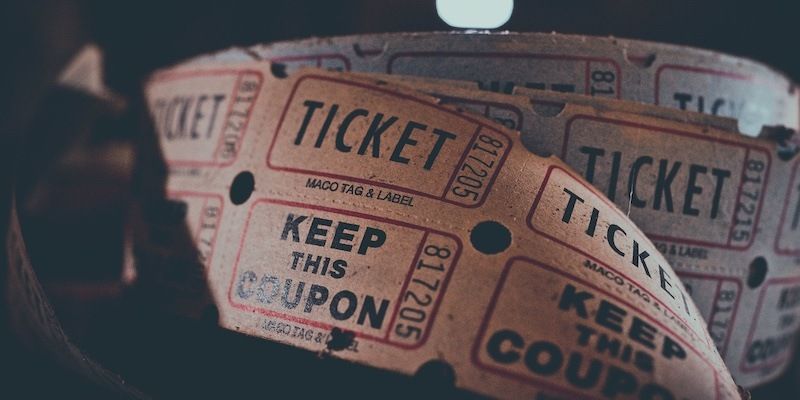

Embracing JOMO: Finding Joy in Missing Out
We’ve probably all heard of FOMO, or ‘the fear of missing out’. FOMO is the currency of social media platforms, eager to encourage us to [...]

The True Meaning of Hedonism: A Philosophical Perspective
“If it feels good, do it, you only live once”. Hedonists are always up for a good time and believe the pursuit of pleasure and [...]

Happiness Economics: Can Money Buy Happiness?
Do you ever daydream about winning the lottery? After all, it only costs a small amount, a slight risk, with the possibility of a substantial [...]
Read other articles by their category
- Body & Brain (48)
- Coaching & Application (57)
- Compassion (26)
- Counseling (51)
- Emotional Intelligence (24)
- Gratitude (18)
- Grief & Bereavement (21)
- Happiness & SWB (40)
- Meaning & Values (26)
- Meditation (20)
- Mindfulness (45)
- Motivation & Goals (45)
- Optimism & Mindset (34)
- Positive CBT (28)
- Positive Communication (20)
- Positive Education (47)
- Positive Emotions (32)
- Positive Leadership (17)
- Positive Parenting (2)
- Positive Psychology (33)
- Positive Workplace (37)
- Productivity (16)
- Relationships (47)
- Resilience & Coping (35)
- Self Awareness (21)
- Self Esteem (37)
- Strengths & Virtues (30)
- Stress & Burnout Prevention (34)
- Theory & Books (46)
- Therapy Exercises (37)
- Types of Therapy (64)

3 Happiness Exercises Pack [PDF]
- Frequently Asked Questions
- Helpful Free Resources
- Happiness & Fun
- Healthy Habits
- Love & Relationships
- Mental Health
- Mindfulness & Peace
- Purpose & Passion
- Fun & Inspiring
- Submit a Post
- Books & Things
- Tiny Buddha’s Breaking Barriers to Self-Care

“Happiness is a direction, not a place.” ~Sydney J Harris
Being happy is for most of us one of the key aims in life. But where we often go wrong is in figuring out which path to take to achieve that happiness.
My own path has been a somewhat unconventional one. In my last year at college, most of my peers were busy applying for full-time jobs with large companies, but I knew that wasn’t what I wanted to do.
I wanted to see the world, which (long before gap years became so common) was met with disapproval by many. But excited, and somewhat scared, I set off alone on my travels.
I didn’t return for good until over seven years later, traveling around the world twice over, working as an English teacher in Istanbul and Barcelona, as a fruit picker on a kibbutz in Israel, in a ski resort, on a campsite in France, and in a fairground in Australia.
I drove across the US, rode the Trans-Siberian railway across Asia, and took precarious bus journeys through the Himalayas and the Andes.
It was a fantastically exciting time and left me with some amazing memories that will last forever. I knew that by doing this I’d probably be sacrificing any chance of reaching the upper echelons of the corporate tree, but that didn’t hold any appeal to me anyway.
Of more concern was the pressure I felt from family, friends, and society to settle down and find a “proper” job. But I’m really glad that I resisted that pressure and didn’t stop traveling and working abroad until I’d seen and experienced all that I wanted to.
I felt that there was plenty of time to have a conventional job after my traveling days were over, and this has proved correct.
The traveling taught me so much about myself, and life, and made me think about what I wanted from this short time on earth. I realized that I wanted to acquire experiences rather than money, and in my subsequent career that is what I have done.
I’ve done a variety of jobs: I’ve been a musician, graphic designer, novelist, and journalist. Much of the time, these have been precarious freelance jobs and not well paid, but they’ve all been fantastically interesting and given me a wealth of life experience.
I always wanted to have no regrets with the way I spent my life, and so far I haven’t. I know that if I’d spent my whole life trying to climb the corporate ladder I wouldn’t have been happy and would now have been lamenting what I hadn’t done in my life.
I’ve always found it really important to enjoy each step of the journey that I’ve been on and not just hoping to be happier at some point later in my life.
The path I’ve chosen may not be for everyone, but it is an example of the importance of choosing your own path in life, and ignoring the pressure from family, friends, and society.
I’ve seen how some people are pressured into certain jobs, often because they are considered prestigious, but hate the path they have chosen. Others may be pushed to get further up the career ladder, but then find out they hate the managerial responsibility that this generally brings.
People also often think that when they have more material goods or money they will be happier . But while it may be hard to be happy in the western world with no money (although some people achieve it) making lots of money and buying lots of things may not necessarily make you content.
Buying a new car or yacht is often only a short-term happiness boost and it seems that after a while, each upgrade to the car, house, or yacht gives less and less extra happiness.
Surveys have shown again and again that once people reach a certain wage—around the average wage in western countries—happiness levels do not increase much.
With relationships, it’s also important to find the right path for ourselves, and to be as sure as we can that we have chosen the right partner. And when we’ve hopefully found them, it’s so important to enjoy each moment of that relationship, not always be looking to the future.
We might think that having children will make us happy, but then when we have them we realize all the responsibilities and difficulties that brings, and may look back on our days without children with fondness. Or if we have young children we might wish they were older, but then they become teenagers!
The common pattern in all this is choosing the right road for the type of person we are and finding happiness at as many places along that route as we can.
So it’s important to look at all the good things in our lives and to enjoy them to the full right now. That is much more likely to bring happiness than waiting for it to appear around the corner.
Photo by woodleywonderworks
About Alex Lloyd
Alex is a writer and life coach. He writes regularly for websites including The Happy Hut , and is the author of the book How to be Happy .
Did you enjoy this post? Please share the wisdom :)
Related posts:

Free Download: Buddha Desktop Wallpaper

Recent Forum Topics
- Feeling depressed and sad..and the wounds are still fresh
- About gutted
- Partner is upset at me.
- Help Me Be Better, I Cheated A Few Times and Regretted It All
- Oh! Life you are complicated.
- Workplace Manipulator
- Breaking up difficulty
- Help with Relationship
- Stuck between stay or go… advice and personal experiences needed,
- Ex back in the picture after 3 years
Fun & Inspiring
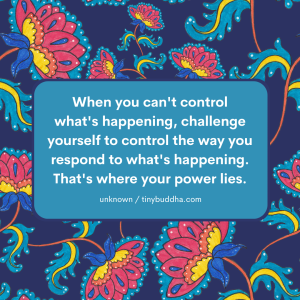
When You Can’t Control What’s Happening
GET MORE FUN & INSPIRING IMAGES & VIDEOS .
Latest Posts

3 Simple Words to Help You Feel Present, Grounded, and Nourished

How I Broke Free from My Toxic Need to Achieve

Hope for the Grieving: You Will Make It Through

How to Find Tiny Miracles, Even During Hard Times

3 Simple Steps to Create More Joy in Your Life
This site is not intended to provide and does not constitute medical, legal, or other professional advice. The content on Tiny Buddha is designed to support, not replace, medical or psychiatric treatment. Please seek professional care if you believe you may have a condition.
Tiny Buddha, LLC may earn affiliate income from qualifying purchases, including from the Amazon Associate Program.
Before using the site, please read our Privacy Policy and Terms of Use .
Click to opt-out of Google Analytics tracking.
Who Runs Tiny Buddha?

Get More Tiny Buddha
- Youtube
- RSS Feed
Credits & Copyright
- Back to Top
Happiness: A Journey, Not a Destination
- Sep 12, 2023
Have you ever considered happiness as a journey rather than a destination? Are you curious about practical strategies to increase your happiness and well-being?
In our pursuit of a meaningful and fulfilling life , happiness often takes center stage. We strive to experience joy, contentment, and a sense of well-being. However, have you ever considered that happiness is not simply a destination to be reached? Rather, it is a dynamic and ongoing journey that requires our active participation and understanding. In this article, we will explore the concept of happiness as a journey, rather than a fixed endpoint. We will delve into the factors that contribute to happiness and uncover practical strategies to enhance our overall well-being. So, let’s embark on this transformative journey and discover the true essence of happiness.
Defining Happiness
Happiness can be described as a subjective state of being that encompasses a range of positive emotions and a sense of satisfaction with life . It goes beyond fleeting moments of pleasure and encompasses a deeper sense of well-being and contentment. While happiness is influenced by external circumstances, it is also intricately linked to our internal thoughts , beliefs , and attitudes.
True happiness is not solely dependent on external achievements or material possessions. It is a more profound and sustainable experience that stems from our relationships, personal growth, meaningful pursuits, and a sense of purpose. It involves finding harmony and balance in various aspects of our lives, including physical, emotional, and spiritual well-being.
Happiness is deeply personal, as what brings joy and fulfillment to one person may differ from another. It is not a constant state, but rather a fluctuating and evolving experience influenced by life’s ups and downs. Happiness involves embracing the present moment , cultivating gratitude, and nurturing positive relationships . It also encompasses self-care, resilience, and a mindset that focuses on the good , even in challenging circumstances.
As we explore the journey of happiness, we will uncover the factors that contribute to our well-being and delve into practical strategies that can empower us to cultivate a deeper sense of happiness in our lives. While it may seem elusive at times, there are several key factors that contribute to the experience of happiness.
5 Key Factors Contributing to the Experience of Happiness
Positive relationships play a vital role in our happiness. The connections we build with our family, friends , and loved ones provide support, companionship, and a sense of belonging. Cultivating and nurturing these relationships by investing time, energy, and genuine care can greatly enhance our overall happiness.
Meaningful work is another significant component of happiness. When we find purpose and meaning in our professional endeavors, we experience a sense of accomplishment, satisfaction, and personal fulfillment. Engaging in work that aligns with our values and allows us to make a positive impact on the world can significantly contribute to our happiness.
Good health is essential for a happy life. When we take care of our physical and mental well-being , we are better equipped to experience happiness. Regular exercise , nutritious eating habits , sufficient sleep , and stress management practices all contribute to our overall health and positively impact our happiness levels.
Gratitude is a powerful tool for enhancing happiness. Taking the time to appreciate the good things in our lives, whether big or small, can shift our focus towards the positive and cultivate a sense of gratitude. This practice helps us recognize the abundance and blessings that surround us, leading to increased happiness and contentment.
Cultivating optimism is also crucial on the path to happiness. Maintaining a positive outlook on life, even in the face of challenges and setbacks, enables us to approach life with resilience and hope. By reframing negative experiences and focusing on possibilities and solutions, we can cultivate an optimistic mindset that contributes to our overall happiness.
5 Effective Strategies to Increase Our Happiness
To increase our happiness, it is important to implement effective strategies that can positively impact our well-being and overall satisfaction with life. While happiness is a subjective experience, there are certain practices and approaches that have been found to enhance our sense of happiness and fulfillment. Here are some key strategies to consider:
- Spend quality time with loved ones : Make a conscious effort to prioritize and invest time in the relationships that matter most to you. Engaging in meaningful connections and shared experiences fosters happiness and strengthens bonds.
- Engage in activities that bring joy : Schedule regular activities that you find enjoyable and fulfilling. Whether it’s pursuing hobbies , engaging in creative endeavors, or participating in sports , these activities contribute to a sense of happiness and well-being.
- Help others : Extend kindness and support to others through acts of generosity, volunteering, or simply lending a listening ear. By making a positive difference in the lives of others, we experience a profound sense of fulfillment and happiness.
- Cultivate gratitude practices : Dedicate a few moments each day to reflect on and express gratitude for the blessings and positive aspects of your life. This simple practice can shift your mindset towards positivity and increase overall happiness.
- Embrace mindfulness : Incorporate mindfulness practices into your daily routine. Mindfulness involves paying attention to the present moment without judgment, fostering a state of awareness and acceptance. This practice reduces stress, enhances self-awareness, and promotes happiness.
Finally, remember that happiness is not a one-time achievement, but an ongoing journey that requires effort and commitment. Set realistic goals that challenge and inspire you, celebrating your accomplishments along the way. Take care of yourself by prioritizing rest, self-care, and maintaining healthy habits. Practice forgiveness, letting go of grudges and resentments that may hinder your happiness. Live in the present moment, appreciating the gifts and experiences that unfold in the here and now. Finally, be kind and compassionate towards yourself, embracing imperfections and learning from mistakes with self-love and understanding.
In the words of Confucius, ‘Happiness is not at the top of the mountain, but in how to climb.’ As you navigate this journey of happiness, remember that the joy lies not just in reaching a destination, but in the steps you take, the lessons you learn, and the growth you experience along the way. Embrace each moment, savor the challenges and triumphs, and continue to cultivate your own unique path to lasting happiness.
The Bottom Line
Choosing to prioritize happiness in your life has far-reaching benefits. It positively impacts your overall well-being, leading to improved physical and mental health , increased productivity, and stronger connections with loved ones. By making happiness a conscious priority and embracing the joys and growth that come along the journey, you open yourself up to a more fulfilling and meaningful life. So, embark on this journey, savoring the moments and choices that contribute to your personal happiness and well-being.
Want to explore more about happiness? Check out these sources and references:
- The Good Life: Lessons from the World’s Longest Study on Happiness by Joseph Waldinger – Buy it here
- The Happiness Lab by Laurie Santos
- Happiness: A Very Short Introduction by Richard Layard
- The How of Happiness by Sonja Lyubomirsky
- Flourish: A Visionary New Understanding of Happiness and Well-being by Martin Seligman
- The Happiness Advantage: How a Positive Brain Fuels Success in Work and Life by Shawn Achor
- Want more happiness? Try this – Harvard Health Publishing
- 10 Practical Ways to Improve Happiness – The Atlantic
- T he Science of Happiness by Psychology Today
- Ten Habits Of Incredibly Happy People by Forbes
- 10 Simple Things You Can Do Today That Will Make You Happier, Backed By Science by The HuffPost
- Action for Happiness: Happier Kinder Together
- The Greater Good Science Center – University of California, Berkele y
- Happify: Science-Based Activities and Games
- Managing Happiness by Harvard University | EdX
- The Science of Well-Being by Yale University | Coursera
- BeWell Program by Stanford
These are just a few of the many references and sources on happiness. I hope this helps!
Subscribe for updates.
Looking for a dose of inspiration, knowledge, and entertainment? Subscribe to our blog newsletter and never miss a single post.
Leave a Comment Cancel reply
You must be logged in to post a comment.
More Related Posts:
Building Strong Relationships: Essential Strategies for Cultivating Trust and Respect
- Jan 02, 2024
In the journey of love, communication, understanding, and respect form the pillars that uphold the […]
How to Not Die Alone: The Surprising Science That Will Help You Find Love
We all yearn for companionship and connection, the warmth of human interaction that makes life […]
The Science of Joy: Exploring 10 Powerful Theories of Happiness
- Dec 01, 2023
Hey there, happiness adventurers! Ever pondered what concocts a life brimming with joy and contentment? […]
The 6 Phase Meditation Method with Vishen Lakhiani
Is Meditation the Missing Piece in Your Life? Have you ever sat quietly, attempting to […]
Winter’s Warmth: Growing Personally and Staying Happy in the Colder Months
Have you ever noticed how winter often brings more than just a chill in the […]
Emotional Dependence: Your Guide to Breaking Free
Have you ever caught yourself feeling like your mood and happiness are on a yo-yo, […]
EDITOR'S PICKS
TODAY'S TOP STORIES
MOST HELPFUL
Subscribe Newsletter
Connect with us!
Copyright © 2023 The Happy Sapiens
Automated page speed optimizations for fast site performance
- Makeup Tips
- Diet & Nutrition
- Relationships
- Entertainment
- Home Improvement
- Safety Tips

What if I told you that happiness is not a destination? What if I told you that you don’t have to wait until you achieve certain goals or reach a certain milestone to be truly happy? In a world that constantly tells us that happiness is something to be pursued and attained, it’s time to shift our perspective and embrace the fact that happiness is not a place we arrive at, but a way of being that we can cultivate in our everyday lives. Let’s explore the idea that happiness is not a destination, but a journey that we can embark on right now.
Table of Contents
- The Misconception of Happiness as a Destination
- Embracing the Journey of Growth and Fulfillment
- Cultivating a Mindset of Gratitude and Contentment
Finding Joy in the Present Moment
Concluding remarks, the misconception of happiness as a destination.
Happiness is often portrayed as the ultimate goal in life, a destination we are constantly striving to reach. However, this is a common misconception. Happiness is not a destination, but rather a state of being. It is not something to be achieved, but something to be embraced and cultivated in our everyday lives.
Too often, we fall into the trap of believing that once we achieve a certain goal, acquire a specific possession, or reach a certain milestone, we will finally be happy. This mindset leads us to constantly chase after happiness, only to find that it remains elusive. The truth is that happiness is not found in external circumstances, but within ourselves. It is a choice we make each day to find joy and contentment in the present moment, regardless of our circumstances.
Embracing the Journey of Growth and Fulfillment
Life is a journey filled with twists, turns, and unexpected detours. It’s easy to fall into the trap of thinking that happiness is a destination—that it’s something we can achieve once we reach a certain goal or milestone. But the truth is, happiness is not a destination; it’s a journey. It’s about embracing the ups and downs, the challenges and the triumphs, and finding fulfillment in the process.
means accepting that life is a series of experiences that shape us and help us grow. It’s about learning to appreciate the small victories, finding joy in the present moment, and staying open to new possibilities. When we shift our mindset from seeking happiness as a destination to cultivating it as a constant state of being, we free ourselves from the pressure of reaching an unattainable goal and allow ourselves to live more fully and authentically.
Cultivating a Mindset of Gratitude and Contentment
Happiness is often viewed as a distant goal, something to be pursued and achieved through external factors such as success, wealth, and material possessions. However, teaches us that happiness is not a destination but a state of being that can be achieved through a shift in perspective and attitude.
Gratitude and contentment are powerful tools that can help us find joy and fulfillment in the present moment, regardless of our circumstances. By practicing gratitude, we train our minds to focus on the positive aspects of our lives, fostering a sense of appreciation for what we have rather than longing for what we lack. Contentment, on the other hand, allows us to find peace and satisfaction in the present moment, freeing us from the endless pursuit of external validation and superficial desires.
Embracing a mindset of gratitude and contentment can have a transformative effect on our overall well-being, leading to greater resilience, inner peace, and a deeper sense of fulfillment. By learning to find happiness in the here and now, we can live more authentically and joyfully, free from the constant pursuit of external markers of success and validation.
Happiness is often portrayed as a far-off destination that we spend our lives striving to reach. We are told that if we achieve certain goals, acquire certain possessions, or reach certain milestones, we will finally be happy. But what if happiness is not a destination at all? What if true joy can be found right here, in the present moment?
When we fixate on the idea that happiness is something to be achieved in the future, we overlook the beauty and joy that surrounds us right now. By learning to find joy in the present moment, we can cultivate a deep sense of contentment and fulfillment, no matter what our circumstances may be. Here are a few ways to embrace the present and discover the happiness that has been within reach all along:
- Practice mindfulness and living in the moment
- Cultivate gratitude for the small things in life
- Engage in activities that bring you joy and fulfillment
- Connect with others and share meaningful experiences
Q: Is happiness something we can achieve and then hold on to forever? A: Can true happiness really be attained and maintained?
Q: Is there a specific formula for achieving everlasting happiness? A: Is there a tried and true equation for achieving never-ending happiness?
Q: Can we just reach a point in our lives where we are completely and consistently happy? A: Is it possible to reach a state of perpetual and unwavering happiness?
Q: Is the pursuit of happiness a futile endeavor? A: Is chasing after happiness a futile and fruitless quest?
Q: Should we stop seeking happiness altogether and instead focus on other aspects of life? A: Should we abandon the pursuit of happiness and concentrate on other facets of life?
Q: What are the benefits of understanding that happiness is not a destination? A: How can recognizing that happiness is not a destination benefit us?
Q: Can we find contentment and joy in the journey rather than focusing on a specific endpoint? A: Is it possible to experience fulfillment and delight in the journey instead of fixating on a specific destination
So, if happiness isn’t a destination, then what is it? It’s a journey, a state of mind, and a conscious choice. It’s about finding contentment and joy in the present moment, regardless of circumstances. It’s about embracing the highs and lows of life and finding beauty in the ordinary. So, instead of chasing after an elusive destination, let’s focus on cultivating happiness in each and every moment. Let’s choose to see the good in the world, practice gratitude, and spread kindness. Because in the end, happiness is not a place we arrive at, but a way of traveling through life. Embrace the journey and make the most of every step.
Discovering Brittney Griner Twin’s Age: A Personal Journey
The unforgettable legacy of alfred hancock: a true visionary, meet katie kroll: the inspiring sister of austen kroll, leave a reply cancel reply.
Log in to leave a comment
Most Popular
Megan’s overtime hustle: how she’s making it work, the intriguing world of meredith bagans: a closer look, the unbelievable talent of darryl baum: a star on the rise, discover brooke monk’s natural beauty: what does she look like without makeup, recent comments, editor picks, popular posts, popular category.
- Lifestyle 5946
- Entertainment 5854
- Relationships 1949
- Wedding 942

- Entertainment & News
- Career & Money
- Health & Wellness
- Love Quotes
- Expert Advice
- Radical Acceptance
- search articles
- find an expert
- sign up for newsletter
6 Remarkable Reasons Finding Happiness Is A Journey — Not A Destination
Is it possible to find happiness right here, right now.
By Karen Finn — Written on Aug 31, 2020

“Happiness is not a destination,” they say. “It’s a journey.” Finding happiness is a mindset, a perspective, a choice. And it has nothing to do with finally reaching the Holy Grail of anticipated, sought-after bliss.
If happiness runs in your veins, this may be preaching to the choir.
RELATED: 4 Ways To Stop Worrying About Every Little Thing (And Get Out Of Your Head)
But for some, the elixir to happiness seems a little more elusive. And hearing that happiness is not a destination isn’t enough to change that.
They need to understand why it isn’t an endpoint.
Are you among those who need a little more convincing?
Here are 6 remarkable reasons finding happiness is a journey and not a destination.
1. any positive change becomes your new "normal.".
The set-point theory of happiness says that your level of subjective well-being is determined primarily by heredity and ingrained personality traits . You’ll naturally experience highs and lows through life experiences, but your happiness level will remain relatively constant.
In other words, based on this theory, your self-perception of happiness will always oscillate around a baseline level . Whether you lose a job or win the lottery, your attitude and emotional state will habituate to the change and return to your “normal.”
The set-point theory has its challenges, but it corroborates one big truth about happiness: It’s not an endpoint. And your set-point can actually be elevated, as you will discover below.
2. Happiness as a "goal" makes you forget enjoying the present.
“I’ll be happy when this year is over.”
“I’ll be happy when I’m out of debt.”
“I’ll be happy when it’s spring/summer/fall/winter/football season/vacation time.”
“I’ll be happy when I lose this weight/get married/buy a house.”
You get the point. It probably sounds silly to contemplate the criteria you so commonly place on your happiness.
The danger of making happiness a goal is that you forfeit your joyful experience of the present. You don’t enjoy springtime, because you’re thinking about summer. You miss the beauty of nature on your walk because you're so focused on losing weight.
You forget to be grateful for the roof over your head because it’s not a house you own. Goals are wonderful to have and achieve, but gratitude and happiness shouldn’t be one of them.
3. You equate failure with misery.
If you attach happiness to a goal — a job promotion, an athletic accomplishment, a romance — and don’t achieve that goal, what happens to the happiness?
This perspective of happiness as a trophy awarded upon achievement of a goal will set you up for misery.
Not only will you miss the beauty and magic of the present, you will also feel tremendous defeat if you don’t get that promotion, win the gold medal, or marry your love interest.
Suddenly, you’re not just living “without happiness,” you’re living with misery.
4. You'll stop perceiving happiness as a "reward."
OK, let’s say you got that promotion. Let’s say you won the gold medal or got to give your acceptance speech at the Oscars. Pretty euphoric moments, wouldn’t you say? But how long did the euphoria last? A week? A month?
Now think back to your anticipation, your training, your envisioning of that glorious moment. Which lasted longer — the journey or the reward?
RELATED: Why Saying ‘Positive Vibes Only’ Is Toxic (And It’s Healthy To Feel Negative Emotions)
An important reason that happiness is not a destination is something called "active anticipation." This is about your enjoyment of the process.
This is why athletes push through the pain and live to smile about it. This is why vacations and weddings are so much fun, despite the stress of planning them.
That moment you dreamed about and planned for may last a few minutes, maybe a few days. But the dopamine hit you get every time you immerse yourself in the planning and envisioning is what keeps you happily in the game.
5. You'll increase the frequency of happy events.
If happiness were a destination or a prize to be grabbed, then that one big dose would have to have a long shelf life. After all, if you’re going to call yourself a "happy person," you have to have enough fuel in the tank to last until the next fill-up, right?
But that’s a pretty risky approach to life. And it certainly doesn’t afford any guarantees that you’ll always get what you’re hoping for.
While certain life events can have a huge emotional impact , both good and bad, the intensity is short-lived. It’s simply not sustainable.
Think about the intensity of falling in love. You don’t eat or sleep, you can’t concentrate, and you don’t always make wise decisions. It’s wonderful and maddening at the same time.
But the true test of that love comes when the hormonal brain-bath drains and you both return to planet Earth. Happiness now comes in the little things. The constant things. The unadorned, unexpected, self-created, mutually enjoyed, day-to-day experiential things.
It’s not the intensity of an event that drives happiness. It’s the frequency of happy events that drive and sustain it.
6. Raising your happiness set-point.
Whether or not the set-point theory holds up across the board, there is one proven way to raise your happiness level: helping others.
A German study found that altruism not only correlates with happiness, but causes it .
If you want to help yourself, help someone else.
Turns out it’s true. And there is research to back it up. There is something inherently elevating about creating value for others. Not only does your own self-esteem get a collateral boost, but your sense of purpose — your perceived value of your own life — does, as well.
There are countless inspirational stories of people who have been happy despite their circumstances. You're humbled and inspired by them because not only do they live their happiness, they exude it.
They give you pause to examine what you have right here, right now — and what can never be taken from you.
Of all the things that happy people know about being genuinely happy, the most important, without question, is this: Happiness is not a destination. It is right here, right now, in every step of the journey.
RELATED: 8 Things Drama-Free, Kick-Ass Girl's Girls Do Way Differently
Dr. Karen Finn is a life coach. Her writing has appeared on MSN, Yahoo!, and eHarmony, among others. You can learn more about Karen and her work at her website.
This article was originally published at Dr. Karen Finn . Reprinted with permission from the author.
- Skip to secondary menu
- Skip to content
- Skip to primary sidebar
- Skip to footer
Virtues For Life
The Heart of Everyday Living is in Virtue
Happiness Is a Journey: 6 Virtues for Daily Happiness
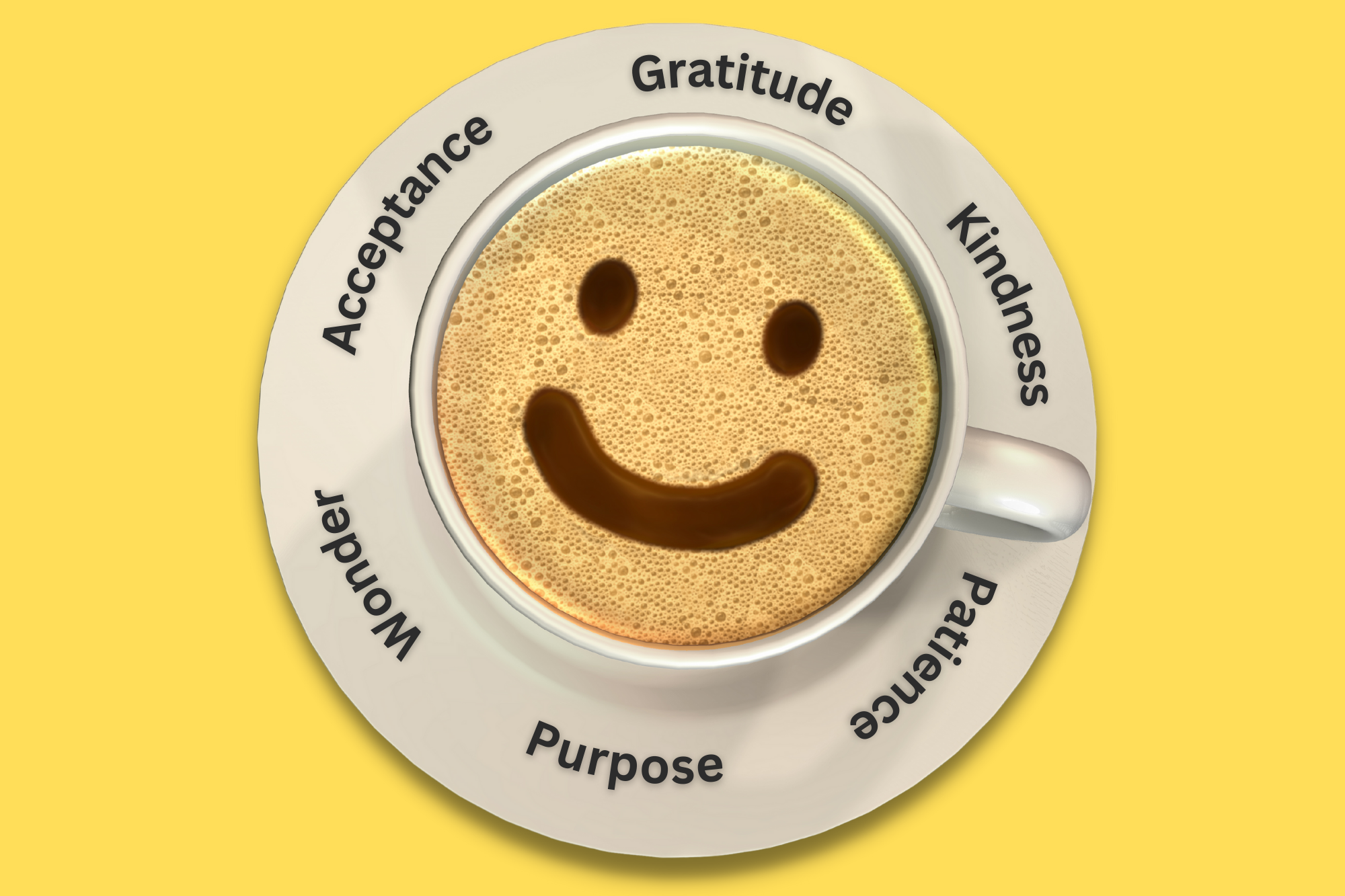
By Manda Lai
An often-heard saying, “Happiness is a journey, not a destination,” is a profound reminder that happiness isn’t a landing place we strive for but rather an ongoing experience.
In other words, to live life fully, we must embrace the present moment by engaging mindfully with the world around us. However, in the whirlwind of modern-day life, it can be easy to lose sight of this philosophy and prioritize our “unfinished business” over our mental health and well-being. But time waits for no one, so it’s important to focus on our happiness along the way.
Fortunately, we can practice six virtues to bring more happiness into our everyday lives—acceptance, gratitude, kindness, patience, purpose, and wonder.
An essential element in our journey of happiness is the practice of acceptance, which involves acknowledging and embracing life as it is. This means understanding that there will always be ups and downs and things out of our control.
Acceptance helps us realize that no matter what happens, we can handle it. Acceptance also makes us more adaptable to change and more resilient in facing challenges.
When we accept things for what they are, we stop dwelling on what could have been, which can be incredibly liberating. We can move forward in our lives. We learn to live in the present and make the most of every moment.
It’s scientifically proven that gratitude is one of the surest paths to happiness. Grateful people are happier, healthier, and more optimistic.
With gratitude, we actively acknowledge and appreciate the simple pleasures and blessings in our lives, shifting our focus from what we lack to what we have. We experience more connection and joy in everyday moments, such as hanging out with friends, feeling the warmth of sunshine, or hearing our favorite song on the radio.
The practice of gratitude grounds us in the present moment. We stop taking things for granted and instead appreciate what is right in front of us.
Kindness is one of the most powerful drivers of happiness. When we are kind, we not only benefit those around us, but we also naturally brighten our own moods.
Kindness is not just a feel-good emotion or gesture but an active choice we can make every day.
With kindness, we shift our focus from ourselves to others and foster a sense of connection and compassion. We become active participants in life instead of passive observers. We do our part to create a better world.
In our fast-paced world, patience can seem like a lost art. We often expect instant gratification and become easily frustrated when things don’t go as planned.
Patience, therefore, is an essential virtue for daily happiness. When we’re patient, we give ourselves time to fully experience life as it happens.
Patience is mindfulness in action. It is the intentional practice of slowing things down and appreciating the journey. We become more aware of our surroundings. We also learn to savor the moment, increasing our happiness.
To experience happiness every day, we must cultivate a sense of purpose . Purpose can be a dream, goal, or vision—anything that motivates and inspires us.
When we are clear about our purpose in life, we develop a strong sense of focus and drive. We become intentional about how we spend our time and experience more satisfaction and fulfillment from what we do every day.
Finding purpose can be daunting, but it’s worth the effort. When we are connected to our purpose, we value each day as an opportunity to work towards something meaningful.
Think back to being a kid. As children, everything was new and exciting. We were curious about the world, and in awe of all it had to offer us.
We can rediscover that sense of wonder as adults. When we do, we come alive with excitement and creativity. We become more willing to take risks and experience new things. We open ourselves up to new possibilities and greater joy every day.
It doesn’t take much to start wondering again. All we have to do is commit to learning something new every day . We can listen to new music, read books about unfamiliar topics, or take classes. Suddenly, everyday life becomes more interesting and enjoyable.
Happiness is not a destination, but an ongoing journey where we learn, grow, connect, and evolve. Happiness is found in the moments we choose to be accepting, grateful, kind, patient, purposeful, and full of wonder.
Happiness is here and now. It’s up to us to take a deep breath, open our minds, and let it in.
So treasure the moments, enjoy the happiness journey, and be present every step of the way.
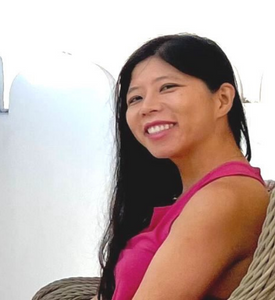
Manda Lai is a physician and Co-Founder of a little dose of happy (aldohappy, “all do happy”), a mission, mindset, and movement dedicated to spreading happiness worldwide. She is passionate about helping people find and cultivate happiness through doing happy, i.e., purposeful action, including kindness, gratitude, empathy, relationship building, and self-care. Visit the a little dose of happy blog to find tips and resources on how to infuse happiness into everyday life.
You May Also Like

Reader Interactions
2023-08-27 at 3:56 PM
Hallo There. Once one learns that a virtuous life leads to happiness, a secret is revealed. Then you wonder why it’s not clear to others. Thanks for your vision to add happiness to our lives. Simple, available to all of us but a choose that only one self can make. Success through out
Leave a Reply Cancel reply
Your email address will not be published. Required fields are marked *
About Virtues For Life
Welcome to Virtues for Life, a website designed to inspire and coach you in the daily practice of virtues to help you become your personal best. Our vision is to create a global consciousness in the difference the practice of virtues can make in everyday life.
- Privacy Policy
- Share Your Story
- Write a Guest Post
- Subscribe To Our Newsletter
Join Our Community
Receive Virtues for Life in your favorite social feed using the links below. Thank you for being part of our community!
- Bipolar Disorder
- Therapy Center
- When To See a Therapist
- Types of Therapy
- Best Online Therapy
- Best Couples Therapy
- Best Family Therapy
- Managing Stress
- Sleep and Dreaming
- Understanding Emotions
- Self-Improvement
- Healthy Relationships
- Student Resources
- Personality Types
- Guided Meditations
- Verywell Mind Insights
- 2023 Verywell Mind 25
- Mental Health in the Classroom
- Editorial Process
- Meet Our Review Board
- Crisis Support
What Is Happiness?
Defining Happiness, and How to Become Happier
Kendra Cherry, MS, is a psychosocial rehabilitation specialist, psychology educator, and author of the "Everything Psychology Book."
:max_bytes(150000):strip_icc():format(webp)/IMG_9791-89504ab694d54b66bbd72cb84ffb860e.jpg)
Rachel Goldman, PhD FTOS, is a licensed psychologist, clinical assistant professor, speaker, wellness expert specializing in eating behaviors, stress management, and health behavior change.
:max_bytes(150000):strip_icc():format(webp)/Rachel-Goldman-1000-a42451caacb6423abecbe6b74e628042.jpg)
Verywell/ Jiaqi Zhou
How to Cultivate Happiness
How to be a happier person.
Happiness is something that people seek to find, yet what defines happiness can vary from one person to the next. Typically, happiness is an emotional state characterized by feelings of joy, satisfaction, contentment, and fulfillment. While happiness has many different definitions, it is often described as involving positive emotions and life satisfaction.
When most people talk about the true meaning of happiness, they might be talking about how they feel in the present moment or referring to a more general sense of how they feel about life overall.
Because happiness tends to be such a broadly defined term, psychologists and other social scientists typically use the term ' subjective well-being ' when they talk about this emotional state. Just as it sounds, subjective well-being tends to focus on an individual's overall personal feelings about their life in the present.
Two key components of happiness (or subjective well-being) are:
- The balance of emotions: Everyone experiences both positive and negative emotions, feelings, and moods. Happiness is generally linked to experiencing more positive feelings than negative ones.
- Life satisfaction: This relates to how satisfied you feel with different areas of your life including your relationships, work, achievements, and other things that you consider important.
Another definition of happiness comes from the ancient philosopher Aristotle, who suggested that happiness is the one human desire, and all other human desires exist as a way to obtain happiness. He believed that there were four levels of happiness: happiness from immediate gratification, from comparison and achievement, from making positive contributions, and from achieving fulfillment.
Happiness, Aristotle suggested, could be achieved through the golden mean, which involves finding a balance between deficiency and excess.
Signs of Happiness
While perceptions of happiness may be different from one person to the next, there are some key signs that psychologists look for when measuring and assessing happiness.
Some key signs of happiness include:
- Feeling like you are living the life you wanted
- Going with the flow and a willingness to take life as it comes
- Feeling that the conditions of your life are good
- Enjoying positive, healthy relationships with other people
- Feeling that you have accomplished (or will accomplish) what you want in life
- Feeling satisfied with your life
- Feeling positive more than negative
- Being open to new ideas and experiences
- Practicing self-care and treating yourself with kindness and compassion
- Experiencing gratitude
- Feeling that you are living life with a sense of meaning and purpose
- Wanting to share your happiness and joy with others
One important thing to remember is that happiness isn't a state of constant euphoria . Instead, happiness is an overall sense of experiencing more positive emotions than negative ones.
Happy people still feel the whole range of human emotions—anger, frustrastion, boredom, loneliness, and even sadness—from time to time. But even when faced with discomfort, they have an underlying sense of optimism that things will get better, that they can deal with what is happening, and that they will be able to feel happy again.
Types of Happiness
There are many different ways of thinking about happiness. For example, the ancient Greek philosopher Aristotle made a distinction between two different kinds of happiness: hedonia and eudaimonia.
- Hedonia: Hedonic happiness is derived from pleasure. It is most often associated with doing what feels good, self-care, fulfilling desires, experiencing enjoyment, and feeling a sense of satisfaction.
- Eudaimonia: This type of happiness is derived from seeking virtue and meaning. Important components of eudaimonic well-being including feeling that your life has meaning, value, and purpose. It is associated more with fulfilling responsibilities, investing in long-term goals, concern for the welfare of other people, and living up to personal ideals.
Hedonia and eudemonia are more commonly known today in psychology as pleasure and meaning, respectively. More recently, psychologists have suggested the addition of the third component that relates to engagement . These are feelings of commitment and participation in different areas of life.
Research suggests that happy people tend to rank pretty high on eudaimonic life satisfaction and better than average on their hedonic life satisfaction.
All of these can play an important role in the overall experience of happiness, although the relative value of each can be highly subjective. Some activities may be both pleasurable and meaningful, while others might skew more one way or the other.
For example, volunteering for a cause you believe in might be more meaningful than pleasurable. Watching your favorite tv show, on the other hand, might rank lower in meaning and higher on pleasure.
Some types of happiness that may fall under these three main categories include:
- Joy: A often relatively brief feeling that is felt in the present moment
- Excitement: A happy feeling that involves looking forward to something with positive anticipation
- Gratitude: A positive emotion that involves being thankful and appreciative
- Pride: A feeling of satisfaction in something that you have accomplished
- Optimism: This is a way of looking at life with a positive, upbeat outlook
- Contentment: This type of happiness involves a sense of satisfaction
While some people just tend to be naturally happier, there are things that you can do to cultivate your sense of happiness.
Pursue Intrinsic Goals
Achieving goals that you are intrinsically motivated to pursue, particularly ones that are focused on personal growth and community, can help boost happiness. Research suggests that pursuing these types of intrinsically-motivated goals can increase happiness more than pursuing extrinsic goals like gaining money or status.
Enjoy the Moment
Studies have found that people tend to over earn—they become so focused on accumulating things that they lose track of actually enjoying what they are doing.
So, rather than falling into the trap of mindlessly accumulating to the detriment of your own happiness, focus on practicing gratitude for the things you have and enjoying the process as you go.
Reframe Negative Thoughts
When you find yourself stuck in a pessimistic outlook or experiencing negativity, look for ways that you can reframe your thoughts in a more positive way.
People have a natural negativity bias , or a tendency to pay more attention to bad things than to good things. This can have an impact on everything from how you make decisions to how you form impressions of other people. Discounting the positive—a cognitive distortion where people focus on the negative and ignore the positive—can also contribute to negative thoughts.
Reframing these negative perceptions isn't about ignoring the bad. Instead, it means trying to take a more balanced, realistic look at events. It allows you to notice patterns in your thinking and then challenge negative thoughts.
Impact of Happiness
Why is happiness so important? Happiness has been shown to predict positive outcomes in many different areas of life including mental well-being, physical health, and overall longevity.
- Positive emotions increase satisfaction with life.
- Happiness helps people build stronger coping skills and emotional resources.
- Positive emotions are linked to better health and longevity. One study found that people who experienced more positive emotions than negative ones were more likely to have survived over a 13 year period.
- Positive feelings increase resilience. Resilience helps people better manage stress and bounce back better when faced with setbacks. For example, one study found that happier people tend to have lower levels of the stress hormone cortisol and that these benefits tend to persist over time.
- People who report having a positive state of well-being are more likely to engage in healthy behaviors such as eating fruits and vegetables and engaging in regular physical exercise.
- Being happy may make help you get sick less often. Happier mental states are linked to increased immunity.
Some people seem to have a naturally higher baseline for happiness—one large-scale study of more than 2,000 twins suggested that around 50% of overall life satisfaction was due to genetics, 10% to external events, and 40% to individual activities.
So while you might not be able to control what your “base level” of happiness is, there are things that you can do to make your life happier and more fulfilling. Even the happiest of individuals can feel down from time to time and happiness is something that all people need to consciously pursue.
Cultivate Strong Relationships
Social support is an essential part of well-being. Research has found that good social relationships are the strongest predictor of happiness. Having positive and supportive connections with people you care about can provide a buffer against stress, improve your health, and help you become a happier person.
In the Harvard Study of Adult Development, a longitudinal study that looked at participants over 80 years, researchers found that relationships and how happy people are in those relationships strongly impacted overall health.
So if you are trying to improve your happiness, cultivating solid social connections is a great place to start. Consider deepening your existing relationships and explore ways to make new friends.
Get Regular Exercise
Exercise is good for both your body and mind. Physical activity is linked to a range of physical and psychological benefits including improved mood. Numerous studies have shown that regular exercise may play a role in warding off symptoms of depression, but evidence also suggests that it may also help make people happier, too.
In one analysis of past research on the connection between physical activity and happiness, researchers found a consistent positive link.
Even a little bit of exercise produces a happiness boost—people who were physically active for as little as 10 minutes a day or who worked out only once a week had higher levels of happiness than people who never exercised.
Show Gratitude
In one study, participants were asked to engage in a writing exercise for 10 to 20 minutes each night before bed. Some were instructed to write about daily hassles, some about neutral events, and some about things they were grateful for. The results found that people who had written about gratitude had increase positive emotions, increased subjective happiness, and improve life satisfaction.
As the authors of the study suggest, keeping a gratitude list is a relatively easy, affordable, simple, and pleasant way to boost your mood. Try setting aside a few minutes each night to write down or think about things in your life that you are grateful for.
Find a Sense of Purpose
Research has found that people who feel like they have a purpose have better well-being and feel more fulfilled. A sense of purpose involves seeing your life as having goals, direction, and meaning. It may help improve happiness by promoting healthier behaviors.
Some things you can do to help find a sense of purpose include:
- Explore your interests and passions
- Engage in prosocial and altruistic causes
- Work to address injustices
- Look for new things you might want to learn more about
This sense of purpose is influenced by a variety of factors, but it is also something that you can cultivate. It involves finding a goal that you care deeply about that will lead you to engage in productive, positive actions in order to work toward that goal.
Press Play for Advice On Reaching Your Dreams
Hosted by therapist Amy Morin, LCSW, this episode of The Verywell Mind Podcast , featuring best-selling author Dave Hollis, shares how to create your best life. Click below to listen now.
Follow Now : Apple Podcasts / Spotify / Google Podcasts
Challenges of Finding Happiness
While seeking happiness is important, there are times when the pursuit of life satisfaction falls short. Some challenges to watch for include:
Valuing the Wrong Things
Money may not be able to buy happiness, but there is research that spending money on things like experiences can make you happier than spending it on material possessions.
One study, for example, found that spending money on things that buy time—such as spending money on time-saving services—can increase happiness and life satisfaction.
Rather than overvaluing things such as money, status, or material possessions, pursuing goals that result in more free time or enjoyable experiences may have a higher happiness reward.
Not Seeking Social Support
Social support means having friends and loved ones that you can turn to for support. Research has found that perceived social support plays an important role in subjective well-being. For example, one study found that perceptions of social support were responsible for 43% of a person's level of happiness.
It is important to remember that when it comes to social support, quality is more important than quantity. Having just a few very close and trusted friends will have a greater impact on your overall happiness than having many casual acquaintances.
Thinking of Happiness as an Endpoint
Happiness isn’t a goal that you can simply reach and be done with. It is a constant pursuit that requires continual nurturing and sustenance.
One study found that people who tend to value happiness most also tended to feel the least satisfied with their lives. Essentially, happiness becomes such a lofty goal that it becomes virtually unattainable.
“Valuing happiness could be self-defeating because the more people value happiness, the more likely they will feel disappointed,” suggest the authors of the study.
Perhaps the lesson is to not make something as broadly defined as “happiness” your goal. Instead, focus on building and cultivating the sort of life and relationships that bring fulfillment and satisfaction to your life.
It is also important to consider how you personally define happiness. Happiness is a broad term that means different things to different people. Rather than looking at happiness as an endpoint, it can be more helpful to think about what happiness really means to you and then work on small things that will help you become happier. This can make achieving these goals more manageable and less overwhelming.
History of Happiness
Happiness has long been recognized as a critical part of health and well-being. The "pursuit of happiness" is even given as an inalienable right in the U.S. Declaration of Independence. Our understanding of what will bring happiness, however, has shifted over time.
Psychologists have also proposed a number of different theories to explain how people experience and pursue happiness. These theories include:
Maslow's Hierarchy of Needs
The hierarchy of needs suggests that people are motivated to pursue increasingly complex needs. Once more basic needs are fulfilled, people are then motivated by more psychological and emotional needs.
At the peak of the hierarchy is the need for self-actualization, or the need to achieve one's full potential. The theory also stresses the importance of peak experiences or transcendent moments in which a person feels deep understanding, happiness, and joy.
Positive Psychology
The pursuit of happiness is central to the field of positive psychology . Psychologists who study positive psychology are interested in learning ways to increase positivity and helping people live happier, more satisfying lives.
Rather than focusing on mental pathologies, the field instead strives to find ways to help people, communities, and societies improve positive emotions and achieve greater happiness.
Finley K, Axner M, Vrooman K, Tse D. Ideal levels of prosocial involvement in relation to momentary affect and eudaimonia: Exploring the golden mean . Innov Aging . 2020;4(Suppl 1):614. doi:10.1093/geroni/igaa057.2083
Kringelbach ML, Berridge KC. The neuroscience of happiness and pleasure . Soc Res (New York) . 2010;77(2):659-678.
Panel on Measuring Subjective Well-Being in a Policy-Relevant Framework; Committee on National Statistics; Division on Behavioral and Social Sciences and Education; National Research Council; Stone AA, Mackie C, editors. Subjective Well-Being: Measuring Happiness, Suffering, and Other Dimensions of Experience [Internet]. Washington (DC): National Academies Press (US).
Lee MA, Kawachi I. The keys to happiness: Associations between personal values regarding core life domains and happiness in South Korea . PLoS One . 2019;14(1):e0209821. doi:10.1371/journal.pone.0209821
Hsee CK, Zhang J, Cai CF, Zhang S. Overearning . Psychol Sci . 2013;24(6):852-9
Carstensen LL, Turan B, Scheibe S, et al. Emotional experience improves with age: evidence based on over 10 years of experience sampling . Psychol Aging . 2011;26(1):21‐33. doi:10.1037/a0021285
Steptoe A, Wardle J. Positive affect and biological function in everyday life . Neurobiol Aging . 2005;26 Suppl 1:108‐112. doi:10.1016/j.neurobiolaging.2005.08.016
Sapranaviciute-Zabazlajeva L, Luksiene D, Virviciute D, Bobak M, Tamosiunas A. L ink between healthy lifestyle and psychological well-being in Lithuanian adults aged 45-72: a cross-sectional study . BMJ Open . 2017;7(4):e014240. doi:10.1136/bmjopen-2016-014240
Costanzo ES, Lutgendorf SK, Kohut ML, et al. Mood and cytokine response to influenza virus in older adults . J Gerontol A Biol Sci Med Sci . 2004;59(12):1328‐1333. doi:10.1093/gerona/59.12.1328
Lyubomirsky S, Sheldon KM, Schkade D. Pursuing happiness: The architecture of sustainable change . Review of General Psychology. 2005;9 (2):111–131. doi:0.1037/1089-2680.9.2.111
The Harvard Gazette. Good genes are nice, but joy is better .
Zhang Z, Chen W. A systematic review of the relationship between physical activity and happiness . J Happiness Stud 20, 1305–1322 (2019). https://doi.org/10.1007/s10902-018-9976-0
Cunha LF, Pellanda LC, Reppold CT. Positive psychology and gratitude interventions: a randomized clinical trial . Front Psychol . 2019;10:584. Published 2019 Mar 21. doi:10.3389/fpsyg.2019.00584
Ryff CD. Psychological well-being revisited: advances in the science and practice of eudaimonia . Psychother Psychosom . 2014;83(1):10‐28. doi:10.1159/000353263
Whillans AV, Dunn EW, Smeets P, Bekkers R, Norton MI. Buying time promotes happiness . Proc Natl Acad Sci U S A . 2017;114(32):8523‐8527. doi:10.1073/pnas.1706541114
Gulacti F. The effect of perceived social support on subjective well-being . Procedia - Social and Behavioral Sciences . 2010;2(2):3844-3849. doi:10.1016/j.sbspro.2010.03.602
Mauss IB, Tamir M, Anderson CL, Savino NS. Can seeking happiness make people unhappy? [corrected] Paradoxical effects of valuing happiness [published correction appears in Emotion. 2011 Aug;11(4):767]. Emotion . 2011;11(4):807‐815. doi:10.1037/a0022010
By Kendra Cherry, MSEd Kendra Cherry, MS, is a psychosocial rehabilitation specialist, psychology educator, and author of the "Everything Psychology Book."

Idioms Meaning
Happiness is a journey, not a destination
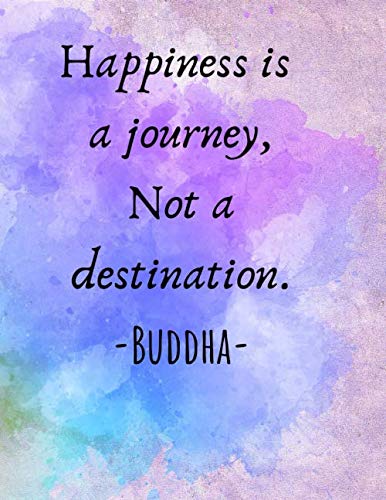
This phrase means that the process of achieving a goal is more important than the goal itself and that being happy is not dependent on achieving a certain result.
Life is a journey, not a destination, so take time to enjoy the small moments along the way.
You must remember that happiness is a journey, not a destination, and that contentment is found in the journey itself.
The phrase “Happiness is a journey, not a destination” was first used by Ralph Waldo Emerson in his essay “Circles” in 1841.
Does this phrase mean we should not set goals?
No, this phrase does not mean we should not set goals. It simply means that being happy and content is not dependent on achieving a goal or destination, but rather on the journey taken to get there.

Finland is the happiest country in the world – but our research suggests the rankings are wealth and status-oriented
PhD Candidante in Organizational Psychology, Lund University
Disclosure statement
August Nilsson does not work for, consult, own shares in or receive funding from any company or organisation that would benefit from this article, and has disclosed no relevant affiliations beyond their academic appointment.
Lund University provides funding as a member of The Conversation UK.
View all partners
Finland steadily ranks as the happiest country in the world. In March 2024 the country was, for the seventh year in a row, ranked as the happiness champion. The ranking is based on one simple question, using a ladder metaphor, that is asked to people across nearly every country in the world. But my team’s new experimental study suggests that the ladder metaphor makes people think about power and wealth.
Since 2005, the Gallup analytics organisation has worked to measure happiness across the entire planet. The mission is particularly important as more and more governments say they are prioritising the wellbeing of their people.
For example, all OECD countries now measure the happiness of their people including the UK . More than a decade ago, Bhutan declared that the primary goal of their government was “gross national happiness” , not gross domestic product.
The world ranking is based on one simple but powerful question, called the Cantril Ladder:
Please imagine a ladder with steps numbered from zero at the bottom to ten at the top. The top of the ladder represents the best possible life for you and the bottom of the ladder represents the worst possible life for you. On which step of the ladder would you say you personally feel you stand at this time?
As you read the question, what does the top of the ladder metaphor make you think of and what does it represent to you? Is it love, money, your family – or something else?
I recently led a group of researchers from Sweden, the US and the UK. We investigated these questions in a study on 1,600 UK adults, and published our results in Nature Scientific Reports . We carried out an experiment with five independent groups.
One group was asked what the top of the ladder represented to them. Another group was asked the exact same question, but this time the ladder metaphor, including the picture of the ladder, was removed and the term “ladder” replaced with “scale”.
Our study found that the ladder metaphor made people think more of power and wealth and less about family, friends and mental health. When the ladder metaphor was removed, people still thought of money, but more in terms of “financial security” rather than terms like “wealth”, “rich” or “upper class”.

In a third group, people interpreted a question where the ladder metaphor as well as the top v bottom description in the question were removed. In a fourth and fifth independent group, in addition to the above changes, the phrase “best possible life” was substituted with “happiest possible life” and “most harmonious life,” respectively.
People in the happiness and harmony groups thought less about power and wealth and more about broader forms of wellbeing such as relationships, work-life balance and mental health, compared to the other groups.
People don’t want the top of the ladder
My research team also asked people where they wanted to be on the scale of the different questions. Researchers often assume that people want the best possible life but, to our knowledge, no one had tested this. The results showed that in none of the groups did more than half the participants want a ten, the best possible life. The typical desire was a nine.
Except for the group with the ladder analogy. They typically wanted an eight. The ladder metaphor made people think more of power and wealth at the expense of relationships, mental health and work-life balance – and made people want a lower score.
What does this say about the happiness rankings where Finland are frequently the champions? Well, there is a risk that the ranking is based on a narrow, wealth and power-oriented form of happiness, rather than a broader definition. This does not mean that Finns are unhappy, but the type of happiness they excel at may be power and wealth-focused.
Our study findings raises the question of what type of happiness we want to measure. A person’s idea of happiness can’t be determined by a researcher. That is why researchers must ask people about their concept of happiness.
Research has shown that when people define happiness, they only mention wealth and status to a small degree. It is well established that money relates to wellbeing but the money effect is weaker than many other happiness factors, where good quality social relationships have the strongest effect .
Recent research from the University of Oxford shows happiness actually causes people to be more productive and the most important factor for happiness at work is belongingness. Salary, on the other hand, is believed to be the most important driver for happiness at work, but it turns out to be a much weaker driver of happiness at work than belongingness . This aligns with the general message from the happiness science that relationships are the most important factor for happiness.
What type of happiness do we want to measure?
Previous research has shown that the Cantril Ladder reflects people’s income levels and social status to a larger degree than other wellbeing metrics . The current study adds more evidence that perhaps the simple but powerful question could be supplemented with extra questions in the future, to clarify what people mean by happiness.
Our study was conducted solely in the UK, so of course this research should be performed in other countries too, given the global nature of this topic. However, our results indicate that we aren’t necessarily measuring happiness and wellbeing in a way that is in line with how we actually define those concepts in our lives.
- Give me perspective

Audience Development Coordinator (fixed-term maternity cover)

Data and Reporting Analyst

Lecturer (Hindi-Urdu)

Director, Defence and Security

Opportunities with the new CIEHF

Happiness Is Not a Destination
Mental health response sometimes make things worse. time for a paradigm shift.
Posted March 30, 2019
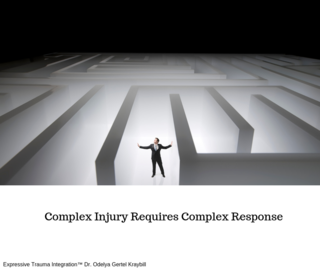
Like others, I read social media posts, magazines, and websites on trauma , personal growth, self-care and more. From all sides I am bombarded with techniques and tools on how to be happy, feel good, fulfil my potential, become resilient (see blog ) and successful and more.
Truthfully, rather than being inspired and uplifted, I often feel discouraged and upset when I read these pieces. Why?
I tried a lot of that stuff. Tried hard. Some things helped for a little while but nothing worked for very long. I might feel better for a few days or weeks, but then I couldn’t sustain the feeling.
After many years of trying, contemplating, being in therapy , expanding my introspect, I finally began to question my expectations of happiness and realized that I needed to figure out a definition that is achievable for me.
To be happy has a unique meaning for each of us. But one thing it does not mean is to live without pain!
Happiness is not a destination In the great chase for happiness that pervades much of today’s thinking, it has come to be understood as a destination, a place we can go and reside if we figure out the magic formula for getting there. “If and when I get that XXX (job/partner/desired weight/house…) then I will be happy!”
But in fact, happiness (however you define it) is a temporary state, one of many on a spectrum of states and feelings that come and go. Whatever we call it, being in such a state does not mean that our pain is gone for good. Underneath it all we all carry a “bag” of pain, that goes with us everywhere, whether we remember and notice it or not, whether we direct our attention away from it, or deny it. Pain and sadness is part of life. It’s here to stay.
Millions of people are doing their best to get to a destination that doesn’t exist, at least not in the form they imagine. So the quest itself, and the fact we are not getting “there” becomes a source of misery.
It keeps us feeling that “we are not good enough”. It dooms us to endless comparing of our ordinary selves to someone else’s extraordinary, perfect social media moment. Bombarded with flashes of the peak moments of others how could we not feel that everyone else is better than us, more successful, more socially desirable,, and of course, happier?
Living in a gap between imagination and reality creates a lot of pain. People turn to all kinds of tactics to survive. Some present the world with a facade of cheerfulness. Others enslave themselves to a drive for material success, or try to anesthetize their pain with “diversionary tactics” (see blog ).
For me, the quest and the many things I tried eventually brought me to a different understanding of what to expect of life and the reality of painful experiences.
Like many others I sought professional help, and ended up in therapy. I came into this with the most common obstacle to growth, the expectation that there is some magic “pill” (therapist, modality, technique, medication etc.) out there that would take pain away.
It took me years of repeated disappointment to figure out that healers of all kinds, including many therapists, are themselves trapped in the magical thinking that drives many people to seek out therapy. With promises of full recovery, healing, reversal of experiences, etc., many talk shows, blogs, and magazines hold out hopes that are irresistible to people in great pain.
How did we get here?
How did therapy come to be understood by many as a medium to find happiness?
How did it become normal to expect that one methodology or another would be enough to truly help people get better, especially survivors of trauma?
How did we come to think that taking a pill, perhaps with psychotherapy or perhaps not, is a sufficient response to mental health symptoms?

At the heart of much of the “magical” thinking I describe above is a simplistic understanding of mental health, regarding both causes of problems and solutions to them. In this view, mental health symptoms are rooted in past trauma (see blog ), often not even recognized as such.
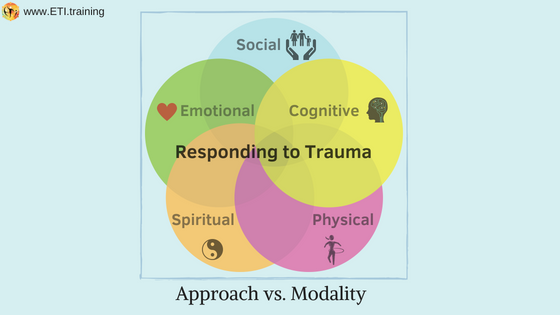
To respond effectively to the injury of trauma, it is crucial to recognize that it deeply affects many aspects of being: (1) Cognitively (ability to process thoughts and make good judgments; (2) Physically (affects our muscles, joints, metabolism, temperature, sleep immune system appetite and weight, etc.; (3) Emotionally (feelings of shame , guilt , sadness, fear , anger , pain) (4) Spiritually (affects our worldview, our understanding and meaning of life, society, and the world; and (5) Socially (affects our relationships with spouses, family, friends, colleagues and strangers.
Complex injury requires complex response . From the moment a critical incident takes place until a trauma survivor gets to trauma therapy responses should target all aspects of wellness (cognitive, emotional, physical, spiritual , and social). See blog .
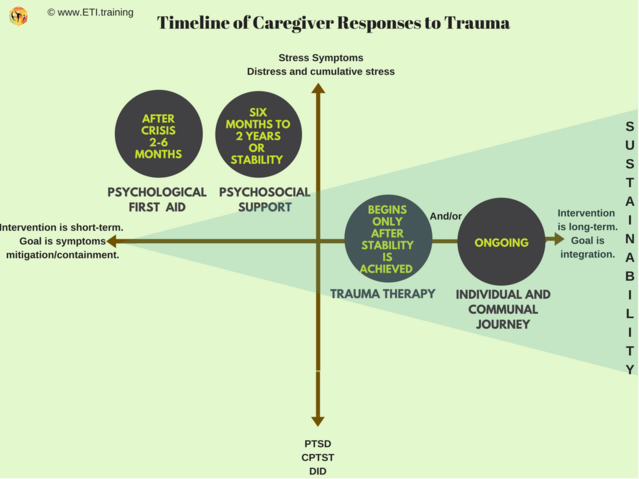
My experience with trauma as a survivor and therapist has made it clear to me that survivors are best assisted by realistic expectations of what can be achieved, and that these expectation are more limited than many therapists seem to suggest to clients. With only rare exceptions, I find clients relieved to engage in a conversation that helps them define realistic expectations for their work in therapy and beyond.
Defining realistic expectations doesn’t bring magical results, of course. In fact, it brings its own challenges as clients turn their attention to things that may seem mundane or even disappointing compared to the “bright stars” expectations that may have carried them for a long time.
Realistic objectives of trauma therapy in my view are : (1) symptoms mitigation - reduction in post trauma stress symptoms and increased capacity to self-regulate ; (2) expanded ability to endure pain and loss caused by the trauma and its aftermath; (3) increased capacity to self-sustain and experience joy with self and others.
The components of an All-Wellness Response include: -In response to critical incidents – provision of psychological first aid (see blog ). - Appropriate psychoeducation – by providing information about trauma and its instinctual mechanisms and impacts on all aspects of living (see blog ). - Expanding capacity to self-regulate by using appropriate techniques and tools that fit each survivor individually (see blog ). -If developmental trauma is part of the picture, using a secure-attunement framework (see blog ). - Designing and implementing a self-sustainability plan (see blog ). A self-sustainability plan is a comprehensive individual program for wellness that has features to address the brain-gut connection ( nutrition ), inflammation, immune system, stress symptoms, sleep, rest, and exercise, brain training, self-compassion , and social engagement.
I wish you well in finding resources within you and around you to create a set of responses and strategies that address all these aspects. I wish for you to define for yourself what it means and does not mean to be happy!

Odelya Gertel Kraybill, Ph.D., is an integrative trauma therapist and scholar who blogs and teaches about sustainable trauma integration in the US and abroad.
- Find a Therapist
- Find a Treatment Center
- Find a Psychiatrist
- Find a Support Group
- Find Teletherapy
- United States
- Brooklyn, NY
- Chicago, IL
- Houston, TX
- Los Angeles, CA
- New York, NY
- Portland, OR
- San Diego, CA
- San Francisco, CA
- Seattle, WA
- Washington, DC
- Asperger's
- Bipolar Disorder
- Chronic Pain
- Eating Disorders
- Passive Aggression
- Personality
- Goal Setting
- Positive Psychology
- Stopping Smoking
- Low Sexual Desire
- Relationships
- Child Development
- Therapy Center NEW
- Diagnosis Dictionary
- Types of Therapy

Understanding what emotional intelligence looks like and the steps needed to improve it could light a path to a more emotionally adept world.
- Coronavirus Disease 2019
- Affective Forecasting
- Neuroscience

Unveiling the Thrilling Adventure of Destination X A Travel Competition Set to Captivate Audiences
D estination X,” the upcoming adventure travel series greenlit by NBC, promises to take viewers on an exhilarating journey filled with mystery, excitement, and competition. Produced by Twofour and based on a popular Belgian format, the show is set to debut in 2025, offering audiences in the United States a unique blend of travel exploration and thrilling challenges. This article delves into the captivating premise of “Destination X,” explores its format, and anticipates its potential impact on the television landscape.
Exploring the Concept of “Destination X”: At the heart of “Destination X” lies a simple yet compelling premise: contestants embark on a once-in-a-lifetime road trip with a twist—they have no knowledge of their destination. As they journey aboard the blacked-out “Destination X” bus, participants must unravel the mystery of their location through a series of challenges and clues scattered along the way. With each episode, viewers are transported to exotic locales, immersing themselves in the thrill of discovery alongside the contestants.
The Game Within the Journey: “Destination X” transforms travel into a high-stakes game, where contestants compete to pinpoint their location on a map. Guided by cryptic clues and unexpected detours, participants must rely on their wit, resourcefulness, and teamwork to outsmart their rivals and reach the elusive destination. As the competition unfolds, alliances form, strategies evolve, and tensions rise, captivating viewers with every twist and turn of the journey.
The Role of Production Company Twofour: Twofour, renowned for its innovative storytelling and captivating reality formats, spearheads the production of “Destination X.” With a track record of successful series like Apple TV+’s “The Reluctant Traveller,” Twofour brings its expertise in creating immersive travel experiences to the forefront. Collaborating with Universal Television Alternative Studio, Twofour aims to deliver a visually stunning and emotionally engaging show that resonates with audiences across the globe.
Executive Producers and Creative Vision: Caroline Davies, Andy Cadman, Dan Adamson, and David Clews lead the creative team behind “Destination X,” infusing the series with their collective vision and expertise. Drawing on their extensive experience in unscripted programming, the executive producers are committed to crafting a dynamic and compelling television experience that captivates viewers from start to finish. Their passion for storytelling, coupled with their dedication to innovation, ensures that “Destination X” stands out as a must-watch series in the competitive landscape of reality television.
Anticipating Audience Engagement: As “Destination X” prepares to make its debut on NBC, anticipation among viewers continues to build. The show’s unique blend of adventure, competition, and exploration is poised to resonate with audiences of all ages, offering a thrilling escape into the unknown. With its immersive storytelling, breathtaking visuals, and suspenseful challenges, “Destination X” promises to redefine the travel competition genre and inspire armchair adventurers around the world.
Destination X” represents a groundbreaking addition to the television landscape, offering audiences an immersive and exhilarating journey into the unknown. With its innovative format, captivating challenges, and stunning production values, the series embodies the spirit of adventure and discovery. As viewers eagerly await its premiere, “Destination X” stands ready to captivate audiences with its blend of excitement, suspense, and unforgettable moments. Get ready to embark on the ultimate travel adventure—a destination where the journey is the prize.


IMAGES
COMMENTS
Your happiness depends on a lot of things, like genetics and life experiences - but as much as 40% is in your control. The way you conceive of happiness can have a big impact on just how happy you are. If you go chasing after it, you may find it slips through your fingers. The expression "Happiness is a journey" is all about thinking ...
Rather than seeing happiness as a destination, it is better to see it as a journey? If we set ourselves the goal of "finding happiness" or "achieving happiness", what happens when we get there? ... Instead, what if we see happiness as a journey that we are constantly taking - we are constantly moving along the road and find many happy moments ...
2. Practise gratitude. Cultivating gratitude is scientifically-proven to increase your happiness journey, and is one of the simplest life changes you can make as it requires little effort. "As the only consistent thing in life is change, believing that happiness is a destination rather than the journey really makes little sense.".
Happiness: a good balance between goal-setting and immediate pleasure. Happiness is defined as a condition of long-lasting fulfilment and joy, in which the individual feels positive about their ...
Journey versus destination. The destination is "like a dot on the map," says Huang, "It's the desired end-state of all our striving." If you're trying to lose 20 pounds, then 20 pounds lighter is ...
Carl Rogers described the good life as a process. Learning to find our own direction in life is key. Ten clues to understand where we are in the process of life. 'The good life is a process, not a ...
Happiness is a journey not a destination. Buddha. After all, achieving and holding onto happiness isn't really possible since happiness is a rather fleeting, evasive, and ever-changing emotion, meaning that even if we can experience happiness at one point, we may later become unhappy again because:
Happiness Is Happiness a Goal or a Journey? ... Happiness Is a Practice, Not a Destination . If you don't find happiness within, there's no GPS that can get you there. Happiness.
Happiness is a journey, not a destination; happiness is to be found along the way not at the end of the road, for then the journey is over and it's too late. The time for happiness is today not tomorrow. Paul H. Dunn. We hope you enjoyed reading this article. Don't forget to download our three Happiness Exercises for free.
Happiness is Not a Destination: How to Enjoy the Journey. By Alex Lloyd. "Happiness is a direction, not a place." ~Sydney J Harris. Being happy is for most of us one of the key aims in life. But where we often go wrong is in figuring out which path to take to achieve that happiness. My own path has been a somewhat unconventional one.
The most common misconception about happiness is that it is the end point of a long and winding journey or a reward for hard-earned achievements. In reality, happiness is not an end goal but a ...
Happiness involves embracing the present moment, cultivating gratitude, and nurturing positive relationships. It also encompasses self-care, resilience, and a mindset that focuses on the good, even in challenging circumstances. As we explore the journey of happiness, we will uncover the factors that contribute to our well-being and delve into ...
Life is a journey filled with twists, turns, and unexpected detours. It's easy to fall into the trap of thinking that happiness is a destination—that it's something we can achieve once we reach a certain goal or milestone. But the truth is, happiness is not a destination; it's a journey.
The pursuit of happiness is an ongoing journey, not a single destination. It involves continuous learning, growth, and adjustments along the way. There will be setbacks and challenges, but ...
Here are 6 remarkable reasons finding happiness is a journey and not a destination. 1. Any positive change becomes your new "normal." The set-point theory of happiness says that your level of ...
In conclusion, it is clear that happiness is not a final destination, but rather a continuous journey that ebbs and flows. It's about how we choose to live our lives every day, finding joy in the small moments, appreciating what we have, and embracing life with all its ups and downs. It requires a shift in perspective, from chasing external ...
Similarly, someone might say "happiness is a destination" to mean that happiness is a specific goal that can be achieved through effort and perseverance. 2. Alternative Meanings. Another exception is when "journey" and "destination" are used in alternative senses that have nothing to do with physical travel or movement.
Happiness Is a Practice, Not a Destination ... but it is our journey through life and our experiences along the way that will truly yield feelings of contentment and satisfaction with our life.
Happiness is a journey, not a destination. This is something that I have learned over the years. There are times when happiness comes easily and naturally, and there are other times when it seems like it is out of reach. No matter what life throws our way, though, we can find joy in everyday moments if we are open to it.
An often-heard saying, "Happiness is a journey, not a destination," is a profound reminder that happiness isn't a landing place we strive for but rather an ongoing experience. In other words, to live life fully, we must embrace the present moment by engaging mindfully with the world around us. However, in the whirlwind of modern-day life ...
Two key components of happiness (or subjective well-being) are: The balance of emotions: Everyone experiences both positive and negative emotions, feelings, and moods. Happiness is generally linked to experiencing more positive feelings than negative ones. Life satisfaction: This relates to how satisfied you feel with different areas of your ...
Life is a journey, not a destination, so take time to enjoy the small moments along the way. You must remember that happiness is a journey, not a destination, and that contentment is found in the journey itself. Origin. The phrase "Happiness is a journey, not a destination" was first used by Ralph Waldo Emerson in his essay "Circles" in ...
People in the happiness and harmony groups thought less about power and wealth and more about broader forms of wellbeing such as relationships, work-life balance and mental health, compared to the ...
1,406 likes, 4 comments - motivationals_orgApril 1, 2024 on : ""Happiness is not merely a destination we reach, but rather a journey we embark on each day through the practice of gratitude, mindfulness, and kindness towards ourselves and others. It's found in the small moments of joy, the connections we make, and the growth we experience alonational studio1 #HappinessJourney #PracticeMakes ...
Happiness is not a destination In the great chase for happiness that pervades much of today's thinking, it has come to be understood as a destination, a place we can go and reside if we figure ...
Nestled in the heart of Northern Thailand, Chiang Mai takes the spot as the happiest travel destination for 2023. With an exceptional total score of 324 points, this city seamlessly blends ancient ...
In the symphony of life happiness isn't a destination to be reached, but a melody to be experienced and danced to, it isn't the pot of gold at the end of a rainbow but it is the rainbow itself, ...
Destination X," the upcoming adventure travel series greenlit by NBC, promises to take viewers on an exhilarating journey filled with mystery, excitement, and competition. Produced by Twofour ...